#They’re all from the 1910s-1930s era
Explore tagged Tumblr posts
Text
Sometimes I think about how Spiderman Noir, Alastor, and Tanjiro are all from the same era.
#They’re all from the 1910s-1930s era#Cause noir is 19 in 1933#Alastor was alive for “the stock market crash of 1929” aka the Great Depression#Tanjiro is from the Taisho era which was between 1912-1926#not about naruto#spider noir#spiderman noir#into the spiderverse#across the spiderverse#itsv#atsv#alastor#hasbin hotel#the radio demon#tanjiro kamado#nezuko kamado#demon slayer#kimetsu no yaiba#kny#I could technically list any character from demon slayer for this#This would be one hell of a crossover#my stooff#rambling
41 notes
·
View notes
Text
While we’re on this topic of old films we watched and enjoyed, some random movie recs from the 1910s through to the 1970s based on the things that popped into my head fastest. Warning in advance, I like horror, noir, swashbucklers, dark comedy and dodgy fantasy films.
1910s
Fantômas serials (1913/1914) – As I said in the previous post, if you ever get a random hankering for silent-era pulpy French crime thrillers, these are an excellent start.
1920s
Metropolis (1927) – the imagery in this movie is absolutely stunning, even if the morals are extremely heavy-handed. Worth it for the Robot Maria transformation sequence alone. Also, and I feel mean for thinking this, because the poor man’s going through hell, but there are moments where Freder is truly hilarious. And also, Batman: The Animated Series owes so much, visually, to this movie. It single-handedly shape a vision of what cities and the future and architecture and transport could look like.
Nosferatu (1922) – imagery. The Germans were so fucking good at imagery in early cinema. Admittedly the movie does some very strange things to the Dracula mythos, and is probably the source of a lot of later ideas of him that have nothing to do with the novel (the sunlight thing), but it’s so cool.
1930s
M (1931) – Peter Lorre is incredible. And actually the whole set up of this movie is so creepy and tense and enthralling, and then the court scene busts it wide open. Deals with some heavy things, including child murder, vigilante justice and mental illness, but it’s so good. And you will never hear ‘Hall of the Mountain King’ the same way again.
The Thin Man (1934) and sequels – they’re half hardboiled noir and half screwball comedy, but they’re not a parody, because they predate most of the noir genre, so this is more of a funny hybrid precursor series. And they’re really funny. If you just want some pep and jazz in your life, a good time for an hour or so, totally watch these, they’re adorable.
The Prisoner of Zenda (1937) – Okay. I just like a good swashbuckler? You will see Zenda several times on this list, because I enjoy a lot of versions of this, but of all of them you need to start with this one, because Douglas Fairbanks Jnr. No one else will ever do Rupert of Hentzau like him. If you like your charming, snarky villains, if you like your Lokis, Rupert of Hentzau. Douglas Fairbanks Jnr. If you also like your villain and your hero to have powerful sexual tension and lean very close to each other while crossing blades, again. Rupert of Hentzau. Just watch. You’ll see.
Son of Frankenstein (1939) – I’m not going to lie, I watched this movie purely to see where Young Frankenstein (1974, also very much worth a look) was getting a lot of its in-jokes and gags from (Inspector Kemp in YF is riffing off Inspector Krogh in this movie). But it is worth watching wholly on its own merits. Among other things, Inspector Krogh is a genuinely cool and compelling character (as a kid, the monster ripped his arm out during its first rampage, and during this movie Krogh fully stands up to that childhood nightmare and has a cool moment with his prosthetic arm), and if you have any interest in Basil Rathbone, Boris Karloff or Bela Lugosi, this movie is fantastic. Lugosi in particular as Igor does so much in this movie. If all you picture when you think of him is Dracula, try this. (And The Black Cat (1934), which also has Karloff and Lugosi, but is significantly more intense).
1940s
The Mark of Zorro (1940) – Okay. I like swashbucklers. I like movie sword fights. This movie has the best movie sword fight ever. Basil Rathbone vs Tyrone Power. No contest. And, I mean, yes, the rest of the movie is also good. But watch it for the sword fight. Perfection.
The Wolf Man (1941) – This movie and Casablanca between them gave me a bit of a thing for Claude Rains. I don’t know, he’s just really compelling to watch. Very soft-spoken, but very there. And if you want the tragedy of the werewolf curse, this is the movie that started it all. This is not a monster movie. This is a psychological horror story of one man breaking apart under the burden of a curse. It’s so good.
Casablanca (1942) – I mean, it’s everyone’s answer. It’s stereotypical, the classic movie. But it is very, very good. Extremely quotable. I wish to punch Rick in the face several times over. And Claude Rains as Renault is so sleazy, but also so compelling.
Arsenic & Old Lace (1944) – If you ever wondered what the deal with Cary Grant was. This movie. His face. The whole movie just rides on his face. His reactions, his body language. I mean, the movie does a lot of things spectacularly. If you enjoy dark comedy, this is the pinnacle. Hiding bodies in window seats, kill count competitions between a psychotic criminal and his maiden aunts, the extremely morbid running gags of ‘yellow fever’ and Teddy charging up the stairs and the elderberry wine. But really it’s all Cary Grant and his fucking expressions. There are several points in this movie where I can’t breathe. For a man with so many suave, serious leading roles, his physical comedy was incredible.
The Big Sleep (1946) – This was the movie that introduced me to noir. Not the Maltese Falcon, not Double Indemnity, not Sunset Boulevard. This one. The Big Sleep. And you can argue that it’s not the best of the noirs, it’s a bit too caught up in itself, the plot if you pay attention has some big holes in it, and if you compare it to the book one female character in particular got rather cheated. But. As an introduction. It does land, very definitely. Bumpy Go-Cart (sorry, Humphrey Bogart) and Lauren Bacall are all that and then some. If you want to pick a noir, you can do a lot worse.
1950s
The Prisoner of Zenda (1952) – Mostly I like this as a compare/contrast to the 1937 one. It’s damn near a shot-for-shot remake, and while that could be a bad thing, it’s fascinating what differences and interpretations show up because of that. Watch the ’37 one first, and then watch this one. It’s just cool to compare them. And, you know. It’s still a really fun swashbuckler.
The Court Jester (1955) – Just the best time. The best. I have an unreasonable amount of fondness for this film, this gentle send-up of previous swashbucklers and period dramas in the vein of The Adventures of Robin Hood, and basically every movie Basil Rathbone ever made. Watch it for Danny Kaye, watch it for the tongue twisters, watch it for a baby Angela Lansbury, watch it for an absolutely hysterical duel scene, watch it for Maid Jean being the single most competent character there. Just watch it. I cannot entertain criticism on this point. It’s excellent, and I’m not sane about it.
Some Like It Hot (1959) – Jack Lemon is going to show up again later in this list, and for good reason, (as is Tony Curtis, but we don’t care as much about him), but Some Like It Hot is also, for a 1959 movie, a really gentle, funny, interesting look at gender roles? I mean, the premise is two dudes going undercover as female musicians with an all-female band to avoid mob hitman, and one of them keeps getting hit on by rich man while the other struggles to get it on with Marilyn Monroe in his male persona while trying to hide from mob assassins in a female persona, so it could be such a hot mess, but it actually … It’s quite gentle. Marilyn’s Sugar gets to talk about what men expect when they see her and, because he’s pretending to be a woman, Tony Curtis’ Joe has to listen to her, Jack Lemmon’s Jerry/Daphne gets to get genuinely swept up in the feeling of being romanced as a woman to the point that he’s semi-seriously talking about marriage, and in the end, when Jerry reveals he’s a man to Osgood, the rich old idiot who’s been trying to romance ‘Daphne’, Osgood famously just goes ‘well, nobody’s perfect’, and still appears perfectly willing to marry ‘her’. I mean, it has its issues still, but there’s such a lot of gentleness in it for a comedy movie made in 1959.
1960s
The Innocents (1961) – One of my two all-time favourite horror movies, on raw atmosphere alone. It’s so eerie. SO EERIE. It’s horrible and twisted and goes heavy places (child death, a child acting ambiguously sexually while possibly possessed, strong questions of sanity), but it’s done so gracefully and gently and eerily. If Gothic Horror is of interest to you as a genre, if you enjoyed Crimson Peak, try this. It is all beautiful sunshine and sprawling lawns and twisted desires and paranoid terrors and the single eeriest scene I’ve ever seen in anything ever. Watch the lake scene. It’s stunning.
The Raven (1963) – Pivoting back to comedy horror, this time with added fantasy. Vincent Price has been in a lot of better movies, but I’m not sure if he’s been in many funnier ones. Him and Peter Lorre just own this movie. Wall to wall ham. Just. Just go in, just watch it. There’s a loose frame plot of duelling magicians, vague references to Poe’s ‘The Raven’, Boris Karloff returning as a villain, animal transformations, and the obligatory young romance getting embroiled in their sorcerous parents’ plots (although, jarringly, the young romantic lead is a baby Jack Nicholson, which sure gives it a weird vibe), but honestly? You’re here for Vincent Price and Peter Lorre and the wizard duel.
The Great Race (1965) – Jack Lemmon is back, as is Tony Curtis, but we only care about the former of those, because Professor Fate (obligatory shouting). Okay. I don’t know how many people remember the old Hanna-Barbera Wacky Races cartoons? Am I aging myself here? But this is the movie they were based on, and Professor Fate is who Dick Dastardly was based on. The premise is a 1910s global car race between Curtis’ Great Leslie (you will want to punch him, and that’s perfectly natural) and Lemmon’s Professor Fate, an exaggerated eccentric conman and cheater and over the top cartoon villain of man, and you will love him. He’s the best thing in it. But there’s also Natalie Woods as the reporter who also enters the race, and a young Peter Falk as Fate’s sidekick Max. That’s a baby Columbo as the ‘villain’s more competent henchman. AND. For me, for bonus points, a huge section at the end of the rest is basically a whole-plot Prisoner of Zenda reference in which Professor Fate is the hero. Look. Look. Do you ever want to watch a live-action cartoon? This is that movie. Trust me. It’s fantastic. The romance has aged terribly, you will want to throw Leslie off a cliff, it has several extremely sixties tropes in it, but it’s that movie. Watch it. Have fun.
1970s
The Golden Voyage of Sinbad (1973) – Right. So. 70s fantasy movie. Not politically correct in the slightest, and some extremely unfortunate choices were made in it. But. Ray Harryhausen. Stop motion fantasy effects of awesome. And, also, I just really enjoyed the character of the Vizier. He doesn’t really get to do anything, he’s kinda just set-dressing, but he is the horrifically maimed advisor to the king who fell afoul of our sorcerous villain, and he has a cool golden mask to cover his scars, and you think he’s going to turn out to be treacherous but no, he’s rock-solid calm and noble and helpful the entire way through, and I just really really like him. The image of him stuck in my head for years.
Picnic at Hanging Rock (1975) – My other all-time favourite horror movie, and again it’s the eeriness. Pure eeriness. Nothing happens in this movie. There’s no monsters, there’s no explanations. 3 girls go missing on a rock in early 1900s Australia, in the midst of baking heat and sunshine and the looming shape of a volcanic geological formation, and the movie just follows their society unravelling in the aftermath. No one knows what happened. Grief and terror and unanswered questions destroy people. Reactions, prejudice, respectability and hidden flaws, loss of innocence, the unpredictable reactions of people unstrung by grief and fear, all of it snowballs in the wake of the disappearances, and over it all looms the sunshine and the rock. The score and the cinematography of this movie work so well to create this pervasive, eerie, unreal mood, this sense of something watching, this ancient force presiding over the unravelling of the false civilisation layered over top of it. I fucking love this movie. It’s stunning.
Assault on Precinct 13 (1976) – A rather big jump in genres, we’re back to crime thrillers here, which we haven’t really touched since the 1910s on this list, but the sustained tension in this movie is par excellence. The opening half hour. A theme for the seventies movies on this list is going to be sunshine and drifting tension, and Precinct 13 does it so well. Heat, claustrophobia, urban isolation, siege mentality. And the character relationships that develop inside that siege mentality, the alliances and bedrock life-or-death trust that evolves between enemies, and then are brutally cut short by the re-establishment of the outside world at the end, the rude reintroduction of law and connectedness and social consequences, is just … amazing. The movie is a heat dream, a bubble of disconnectedness and violence and blood and faith, and then the ‘real’ world slams back down at the end. It’s good. It’s so well paced. Watch this movie.
Nosferatu (1979) – Just to, again, tie things back to the earlier entries on this list. Werner Herzog’s 70s remake of Nosferatu was actually the first version I saw, as it was considerably easier to get hold of. And it stuck. Even after seeing the original. And a lot of that, I think, was because of the opening, which is just spectacularly eerie. The drifting, eerie music, the monastic chant, the heartbeat under it, the panning shots of the mummies in the catacombs (which are from Mexico, but howandever). I mean, there are a lot of problems with this movie, Werner Herzog is not exactly the most upright and sensitive of dudes, (and it added some more questionable elements to the Dracula mythos), but for sheer imagery and tone-setting, this opening was incredible. And the movie does keep that tone, that eerie drifting, especially once Dracula starts bringing the plague behind him. Again, the 70s theme of sunshine and eeriness. It’s worth a look.
#movie recs#classic movies#1910s#1920s#1930s#1940s#1950s#1960s#1970s#horror#swashbucklers#crime thrillers#fantasy#noir#comedy#random selection based on my idiosyncratic memory
13 notes
·
View notes
Photo







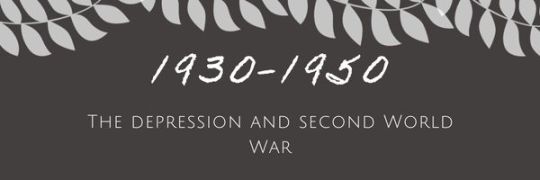


I forgot to post the general challenge-wide rules earlier but here they are. Although I will probably to fine-tune these as I go along with the challenge (it’s my first time playing it)...

From the revolution to the moon! 1780-1960’s a North American history inspired challenge for the Sims 4
This is a historical challenge made for Sims 4 which draws inspiration from other previous historical and non historical challenges. It takes your main family through 200 years of North American history from the late 18th Century to 1970’s, or in other words from the revolutionary war to the moon mission in 1969. The rules are also made appropriate for the different time periods but with room for gaming enjoyment. Just a warning, I am no historian or even American so this one won’t be 100% accurate but I have tried to do my research as best as I can.
Introduction:
The challenge includes 10 different stages, one generation for each so, 10 generations of sims = 200 years (20 years per generation)
The stages/decades include: 1) 1770-1790, 2) 1790-1810, 3) 1810-1830, 4) 1830-1850, 5) 1850-1870, 6) 1870-1890, 7) 1890-1910, 8) 1910-1930, 9) 1930-1950, 10) 1950-1970
Or as they’re called in the challenge 1) The Revolution 2) Industrial Revolution 3) Imperialism 4) Indoor Plumbing! 5) Civil War 6)The gilded age 7)The suffragette movement 8) The roaring 1920’s 9)The depression and second World War 10) Atomic Age and Race to the Moon
I may need to find a better theme/name for the 4th :D
You enter a new generation/stage once the heir of your current heir (for the first 6 generations this is the eldest male child) reaches the young adult stage
The challenge begins with the first couple moving to a modest lot with one room house that has no plumbing/electricity. The challenge begins with 100 simoleons and the goal is to gain as much money and game points as possible by the 1970’s.
Every generation has a number of time period appropriate goals and also chaos factors which can cause negative effects on the gameplay such as deaths, disasters and loss of money. To counter this there are also some positive chaos factors added in.
I have most of the expansions and stuff packs so I designed the game for those that I have, so if you have only the base game you may need to make up some rules yourself.
Points (some have been borrowed from the History Challenge):
Each stage in the challenge has their own goals but there are also challenge wide goals. (I may come up with more as I go along but these are ones I’ve come up with so far)
By the end of the challenge the amount of money your family has gained means the more points you get:
100 000 simoleons = 10 points
500 000 = 20 points
1 000 000 = 30 points
1 500 000 = 40 points
2 000 000= 50 points
over 2 500 000 = 100 points
Earn 10 gold medals on different types of social events - 10 points
Reach level 10 in 3 careers (can be different sims, either heir or their spouses) - 30 points
Have the same Sim earn at least 20 000 Satisfaction points - 20 points
Complete at least 10 in-game collections, can be different sims – 20 points
Represent each Era with a family portrait/photo – 10 points
Display the graves/urns of all deceased heirs and their spouses on the challenge lot or on a dedicated graveyard lot - 10 points
If you have Get Famous, make your sim earn a pristine reputation and another sim, an atrocious reputation - 10 points for each
Have your sim father/mother five children with five different partners 10 points
Have the same Sim be father/mother to at least 10 children - points
If you have Get Together, make 10 friends and create a club -10 points
#sims 4#ts4#the sims#the sims 4#sims 4 challenge#challenge#historical#historicalsimslife#from the revolution to the moon#frtm#history challenge#ts4 challenge#gaming
248 notes
·
View notes
Text
“Labours of Love”
Summer Holmestice 2021 for “Ghostbees”
After my giftee ( @ghostbees ) mentioned "scrapbooking" and "English paper piecing" I went down a rabbithole of research and learnt about this wonderful quilting technique.
From the EQS website: "English Paper Piecing is a method of quilting that involves using a paper shape, most commonly a hexagon, to add stability to the quilt. The quilt is hand stitched with pieces of fabric cut a ¼ inch bigger than the paper shape. The fabric is basted to the paper shapes before the shapes are sewn together. Once the quilt top is completed the papers are removed." The technique dates from 1770s and was popular during the early 1800s in the UK, then in the mid 19th century in the US and it made a comeback during the Great Depression of the 1930s, when the pattern was called in the sewing magazines "Grandma's Flower Garden", but before that it was simply known as hexagonal pattern or (you guessed it) honeycomb pattern. The paper used for these quilts were usually recycled from newspapers or scrapped letters, and the fabric used to come from old garments that had seen better days, and since a lot of the times the paper was simply left in these quilts are marvelous time capsules that contain a wealth of information about the person who made them and their environment. I encourage you to look up English paper piecing (EPP) quilts from the early Victorian decades, they're fascinating!
So this little series of illustrations shows Watson dealing with Holmes still indulging in scrapbooking, and how the doctor picks up the discarded pieces and their old 221B era clothes to make something entirely new and uniquely theirs.

1. I keep seeing lovely examples of Victorian silk braces with floral embroidery and I couldn’t resist giving the boys some fancy ones. Also I know that a bright pink and blue shirt is probably not too historically accurate 1910s but screw it, trans flag shirt colours!
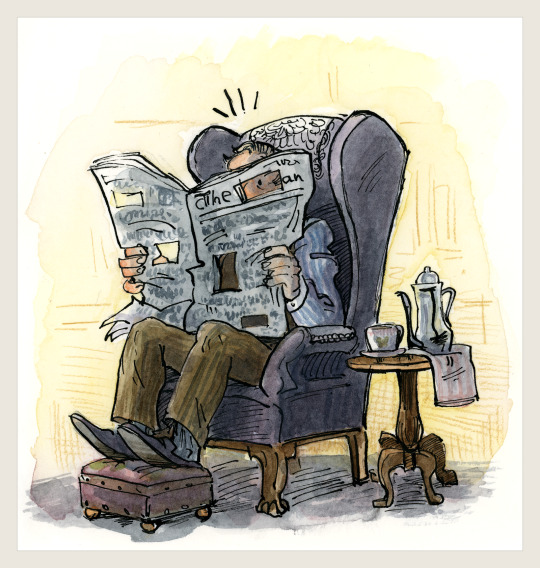
2. I both hate and love drawing furniture. Footstools/ottomans are cute, though.
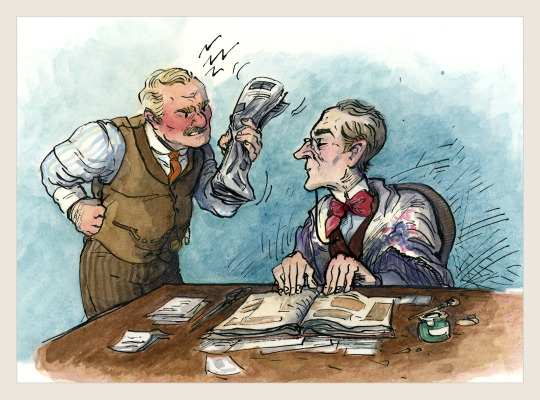
3. “My dear fellow, if you didn’t spend all morning in bed instead of reading the newspaper as soon it arrives all of this could be avoided.” Also Holmes is wearing a silk piano shawl because what are gender norms?

4. Holmes not only uses newspaper clippings for scrapbooking, but per Ghostbees’ suggestion I looked briefly into the Victorian hobby of pressing and collecting seaweed and I think it would be a fantastic subject for Holmes to branch out to (especially if there’s any poisonous types).

5. Old dressing gowns and blankets that have seen better days. The moths got ahold of them but I’m pretty sure the constant chemical experiments back at 221B claimed more than one victim.
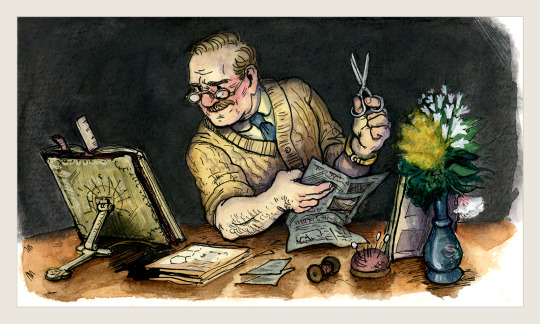
6. I got a bit carried away with the ink and gouache here. But it was fascinating to see the first published patterns in magazines making their appearance, especially in publications aimed at women that contained a wide range of home-related subjects.

7. Someone in the Dreamwidth website pointed out that both Holmes and Watson are working on beehives and that warmed my heart. One interesting bit about EPP is that the paper can be left inside the quilt, so historians have been able to gather very detailed information about the person who crafted these pieces and their life.
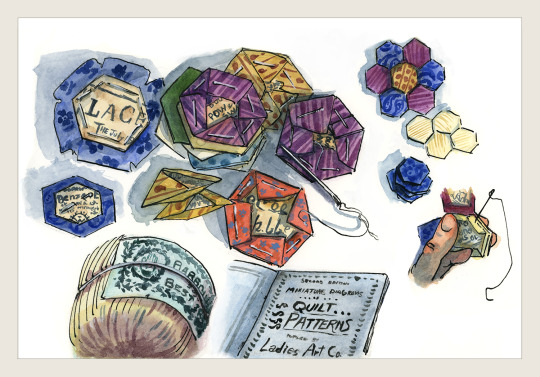
8. Oh god so many hexagons. Here’s an example of one of those magazines with patterns and instructions.
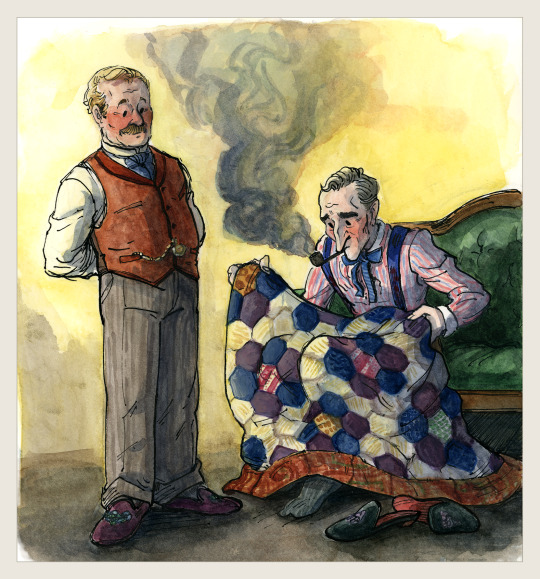
9. I had too much fun giving them embroidered slippers. It’s a shame I overdid the watercolours and turned out quite muddy, but I would love to draw their clothes in more detail in the future.

10. Smooch! (Also the paisley trim is my favourite part)

11. Initially I wanted this story to end in a picnic at Beachy Head, until I was told that quilts aren’t picnic blankets and are more appropriate for domestic use only. You still get to see some of the cliffs at least!
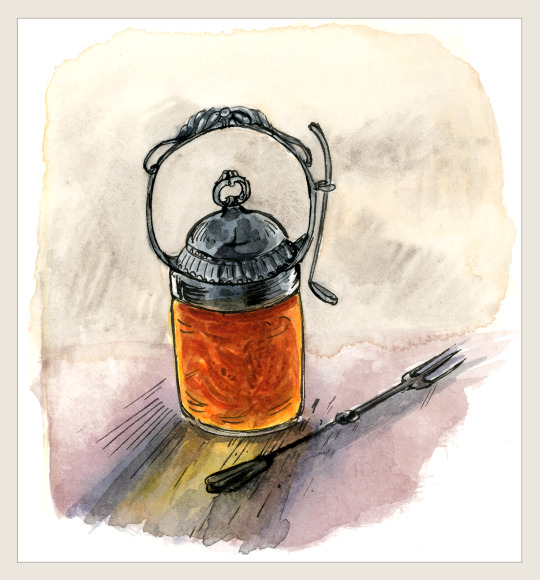
12. Another accidental discovery during my research: pickle and marmalade jars! I could draw a hundred of them and not get tired. That little spoon! Ugh!
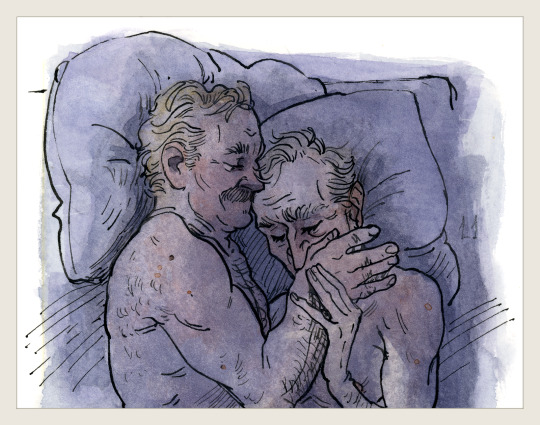
13. I will never not cry about these two old fools in love.

14. Cross stitching and lettering isn’t my forte, nor is Watson’s, but I saw several quilts had names sewn into one panel, almost like a painter signing their canvas, or dedicating the piece to a loved one. So you know I had to add this little detail, plus some green carnations for extra queerness, a forget-me-not flower and a plump bee because I have to be extra.
Looking back this is one of the things I’m the most proud of that I have made this year, or even longer. I work digitally for my job and I miss the feel of traditional materials, so this was a project that let me flex those watercolour muscles and try gouache for the first time. All while drawing incredibly indulgent things, so thank you Basil for giving me an excuse to have some fun.
#my art#long post cw#Sherlock Holmes#Dr Watson#John H Watson#Holmestice#Holmestice 2021#Holmestice Summer 2021#Holmes/Watson#Holmes x Watson#ACD Johnlock#Victorian Johnlock#Granada Johnlock#Victorian Husbands#Arthur Conan Doyle#Victorian fashion#Edwardian fashion#EPP#English Paper Piecing#historical sewing#quilt art#traditional art#watercolour art
1K notes
·
View notes
Text
Eras of Women’s Historical Fashion: Ranked!
Everyone knows old clothes are cool and interesting, but have you ever wondered exactly which eras were the sh*t for fashion and which were just meh? Wonder no more. Despite the fact that this ranking is based entirely on my own personal judgement, all my decisions are final and correct.
This is mainly focused on clothes in Europe and the Americas because that’s what I’m an expert in, and also because I could never decide which eras of fashion from say, India or China are the best. They’re all equally gorgeous. Don’t make me choose.
The List!
1. Late 1870s/Early 1880s

This is when women’s fashion peaked. That fitted silhouette! The collars! The hair! This was the “natural form” era when you weren’t expected to wear a bustle, just a little bum pad. Like a Kardashian.
2. Late 17th Century
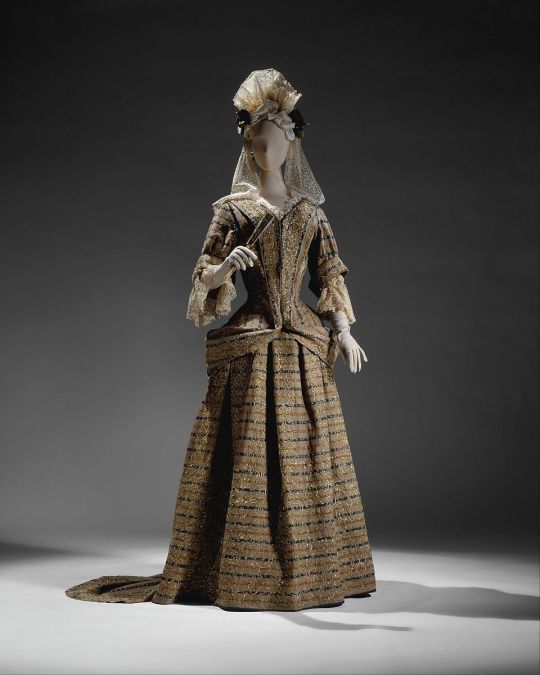
Remember how “The Favourite” was an amazing movie? That was 50% the acting and writing and 100% the fashion. Look at that lacy hat and lacy sleeves and lacy everything. Also, that skirt shape is the best.
3. The 1860s
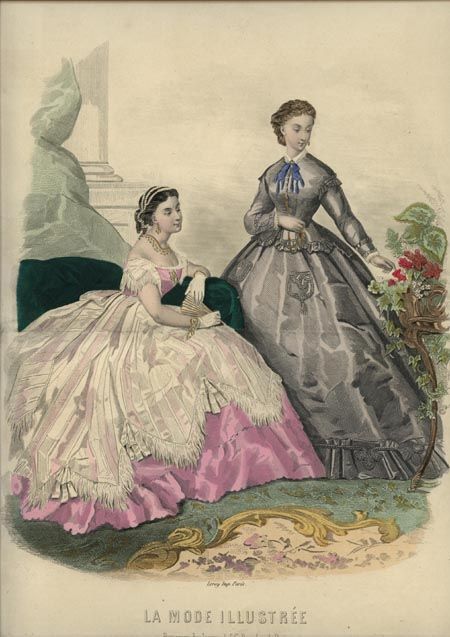
The reason this era was so amazing was crinolines. Crinolines ensure social distancing, provide air conditioning, and make it 100% funner to twirl.
4. The 1930s

The 1930s were a difficult time for America and the world but if you flip through a Sears catalog of the era you kind of forget about all of that.
5. The Mid-18th Century

The concept of “too much” didn’t really exist in the 1750s, which is why Madame de Pompadour always looked on point in her portraits. I would love to get away with wearing a dress that had that many bows.
6. Bustle Era (1870s-1880s)
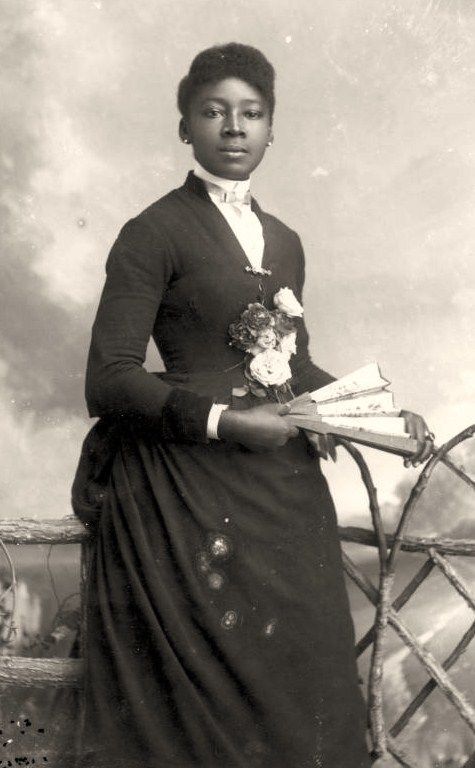
Not only are bustles sexy as hell, but they provide another social distancing guarantee.
7. Late 1910s

Highly underrated era. I cannot get over those tiered skirts and cropped jackets.
8. Early-Mid 15th Century

Have you figured out by now that I kind of have a thing for fitted bodices and big skirts? They’re just so flattering.
9. Late 1940s/Early 1950s

I have no idea what the Dior company is doing now and I don’t care. This is when they peaked. Stop trying to reinvent the wheel, Dior, and go back to this.
10. Early 1800s/ Regency Period

Clothes from Jane Austen’s era were extremely cute, but I cannot pull of a dress that high-waisted, which is why they are number ten on this list.
Bonus: What was the absolute worst era of women’s historical fashion?

The 1830s are canceled. We shall not speak of them again.
815 notes
·
View notes
Text
𝔯𝔢𝔪𝔢𝔪𝔟𝔢𝔯 𝔪𝔢 𝔣𝔬𝔯 𝔠𝔢𝔫𝔱𝔲𝔯𝔦𝔢𝔰 [nct collab call]

take a look inside the chapters of this history book and read of several events spanning across all of human civilization. read about people from all walks of life: great heroes, legendary foes, daring outlaws, ordinary people. read about the rise and fall of empires, conspiring courts, the rise and fall of empires, forbidden alliances and romances. in fact, dear reader, don’t just read. learn from the past, because if we don’t, we are doomed to repeat it.
𝖋𝖔𝖗𝖊𝖜𝖔𝖗𝖉
in lieu of hitting 500 followers, i’ve decided to announce this collaboration!! i’ve always loved history so why not? some of these eras are specific to certain cultures and places, but others are a lot broader. at the end of the day, they’re your stories. also if you saw me post this on accident the first time... no you didn’t <3
𝖋𝖔𝖗 𝖞𝖔𝖚𝖗 𝖈𝖔𝖓𝖘𝖎𝖉𝖊𝖗𝖆𝖙𝖎𝖔𝖓
this is a historical au collaboration, but any genre is allowed as long as your story is set in your chosen era! however, smut is not allowed for jisung or if you, the writer, are underage.
all works must be member x reader. love triangles and the like are allowed, but the main male character must be the member you chose.
eras and members are chosen on a first come, first served basis. please message me if you want to participate! if your main blog isn’t your writing blog, please be sure to tell me your writing blog so i can add it to this list correctly :)
you must have discord, since i will be sending all writers working on this collaboration a discord server link. there, i will send announcements and we can all give each other feedback!
tag any triggering content. if you’re not sure, ask in the discord server!
research is definitely encouraged as you will be writing about historical eras, some with specific cultural significance! please be respectful of any cultures or traditions you write about.
in the same vein, don’t romanticize any historical events or figures that are controversial, or have had negative cultural impact (ie, 9/11, the crusades, colonialism). again, if you’re not sure, ask in the discord server!
minimum word count is 2k. your words cannot be blurbs or timestamps.
please inform me if: you’re changing your url, you’re going on hiatus, or if you need to leave the collaboration.
the deadline is currently november 2021, but it is very flexible and can be pushed back even further should several writers ask!
after you’re added, i would really appreciate it if you reblogged this post to boost its reach :D
𝖈𝖍𝖆𝖕𝖙𝖊𝖗 𝖎𝖓𝖉𝖊𝖝
moon taeil -
johnny suh - @aquamoonchaii - the joseon dynasty
lee taeyong - @moondustaeil - the victorian era
nakamoto yuta -
qian kun -
kim doyoung - me! - the renaissance
lee ten - @sleepylixie - the 1940s
jung jaehyun - @doderyscoffee - the rococo era
dong sicheng - @loonacitys - the regency
kim jungwoo - @smileyjaeminies - ancient greece
wong yukhei -
mark lee - @lamaiejeno - the 1920s
xiao dejun -
wong kunhang - @zephyr-abyss - the golden age of piracy
huang renjun - @seulgiswhoreee - the 1930s
lee jeno - @jenoentry - the roman empire
osaki shotaro -
lee donghyuck -
na jaemin - @jaehyyns - the 1960s
liu yangyang - @lovelyutas - the late middle ages
zhong chenle - @softcrescendo - the tang dynasty
jung sungchan -
park jisung - @heejinnien - the three kingdoms period
𝖈𝖍𝖆𝖕𝖙𝖊𝖗 𝖚𝖓𝖎𝖙𝖘
listed below are historical eras to choose from, a brief description of them (except anything past the 1900s as they’re pretty self explanatory), and a few examples of media or cultural phenomena you could use as inspiration if you can’t think of anything! media will be in italics, cultural phenomena will not.
ancient greece (800 BCE—32 BCE): a civilization based in the mediterranean, known for its extensive mythology and advancements in math, art, western philosophy and government. inspiration: the odyssey, hercules, the iliad, percy jackson.
the han dynasty (206 BCE—220): known for its long reign and achievements, it was the second imperial dynasty of china. it is highly regarded as an age of peace and prosperity that allowed china to grow into a major world power. inspiration: painted skin, the virtuous queen of han, the king’s woman
roman empire (27 BCE—476): in its time, this was one of the most powerful empires in the “known world” as a result of its political prowess and military power. it spanned from england, to the mediterranean, to parts of the middle east. inspiration: the heroes of olympus, pompeii, gladiator
the tang dynasty (618—906): regarded by many as china’s golden age of arts and culture, the tang dynasty allowed aristocratic life to flourish. poetry, art, and education prospered. inspiration: house of flying daggers, the empress of china
the viking age (793—1066): time period in scandinavian europe during which vikings conquered parts of north america and england. inspiration: vikings, how to train your dragon trilogy
the three kingdoms period (892—936): period in korean history in which the korean peninsula was split into three kingdoms, all wanting to conquer one another: goguryeo, silla and baekje. inspiration: the blade and petal, hwarang
feudal japan (1185—1602): period of civil unrest in japan, during which the political world was unstable, and power fluctuated between the shogunate and the royal court. it can be separated into two main eras: the kamakura period, and the sengoku period. inspiration: samurai, inuyasha, hakuouki
the late middle ages (1250—1450): a relatively brutal period, known for its numerous wars and civil unrest, throughout europe and asia. inspiration: the princess bride, robin hood, marco polo
joseon dynasty (1392—1897): the last and longest ruling confucian monarchy in korean history. inspiration: 100 days my prince, mr. sunshine, rookie historian goo hae-ryung
the renaissance (1450—1600): period based in europe (mainly italy) which was known for its advances in art, technology and science. inspiration: shakespeare in love, romeo and juliet, ever after
the golden age of piracy (1650—1730): during which maritime piracy across the world grew more and more prominent due to large shipments of cargo making their way to places like the caribbean, west africa, north america and europe. inspiration: pirates of the caribbean, treasure island
the rococo era (1737—1770): art movement in europe which glamorized grandeur and luxury, revolving around heaven, angels, love and lavishness. inspiration: barry lyndon, marie antoinette, a little chaos
the age of revolutions (1765—1849): a period in which a shift occurred in the western world, and monarchical institutions were overthrown in places like latin america, north america, and france. inspirations: les miserables, hamilton
the regency (1795—1837): british time period surrounding the time before, during, and after which prince george of england iv ruled as prince regent after his father was deemed unfit, during which time aristocracy flourished. inspiration: pride and prejudice, emma, bridgerton
victorian era (1837—1901): period spanning the rule of queen victoria of england, during which the industrial revolution occurred and urbanization became widespread. inspiration: the young victoria, the phantom of the opera, penny dreadful
the old west (1860—1890): period in american history during which many made the dangerous decision of migrating west of the Mississippi river, in search of gold, new land, and money. inspiration: jane got a gun, the good the bad and the ugly
the 1900s: moulin rouge!, finding neverland
the 1910s: downton abbey, my fair lady, anastasia
the 1920s: the great gatsby, boardwalk empire, silent films
the 1930s: bonnie and clyde, the handmaiden, the beginning of hollywood’s golden age
the 1940s: casablanca, the godfather, the notebook
the 1950s: swing kids, grease, dead poets society
the 1960s: american graffiti, the british invasion, summer of love
the 1970s: the lovely bones, mindhunter, the birth of punk music
the 1980s: atomic blonde, stranger things, the americans
#nct smut#nct fluff#nct angst#nct au#nct scenarios#nct x reader#kpop x reader#kpop scenarios#kpop angst#kpop fluff
145 notes
·
View notes
Text
Introduction to Australian Cinema and Ozploitation
Australia was the county that kickstarted the film industry we know today over a century ago in 1906, with the feature film The Story of the Kelly Gang, directed by Charles Tait, but with the rapid rise of American cinema in the 1910s and 1920s, Australian film saw a huge decline in their success and production of films. With this decline came desperation, and with the Australian film industry losing money, they turned to the United States, seeking products that were now way too expensive to make in their own country for their films, as it was much cheaper to get their products imported than making them themselves. As a result of the decline of the Australian film industry, by 1923 American films basically took over the Australian market, with an astounding 94% of all of their films coming from the United States.
In the 1930s, Australia began to make steps in righting the ship in regards to their film industry with the creation of Cinesound Productions in 1931. This Australian film production company was one of Australia’s first major feature-film producers, but despite its praise, it didn’t last. Cinesound Productions was financially successful even though they only produced only 17 feature-films, but due to WWII, they stopped their filmmaking in 1939.
Australian film was finally going in the right direction in the 1940s and 1950s. Kokoda Front Line! (1942), directed by Ken G. Hall was a very successful Australian film, winning Australia's first Oscar. Other Australian hit films in the 1940s included those with the brilliant Australian actor Chips Rafferty. He was known for acting like a typical Australian in his acting roles, which gained the attention of many Australians. Films like Forty Thousand Horsemen (1940), The Rats of Tobruk (1944), The Overlanders (1946) and Eureka Stockade (1949) starring Rafferty did surprisingly well, and received much praise. The 1950s were also successful for Australian films. In 1958 the Australian Film Institute was formed, and in the same year began awarding the Australian Film Institute Awards.
As for the 1960s, this is when Australian film became another decline. With only a couple notable films released in this decade, drastic changes were going to be needed in order for the industry to stay afloat. What needed to happen? Well, there was one film in particular in the 1960s that did pave the way for a new era in Australian film. Starring Chips Rafferty and Walter Chiari, the comedy They're a Weird Mob (1966) directed by Michael Powell, sparked an idea that was needed for Australian film to shine, which led into the “Australian New Wave,” and the idea was to exploit Australian culture. With this era in Australian film emerged the Ozploitation style.
With the introduction of the R rating in 1968, The Ozploitation style took genres like horror, comedy, sexploitation and action films to heart, presenting the wild side of Australia in the process. The 1970s and 1980s were known as the "golden age" of Australian cinema, with tons of hit films like Picnic at Hanging Rock (1975), Sunday Too Far Away (1975), Mad Max (1979), and Crocodile Dundee (Peter Faiman, 1986). The Ozploitation style also introduced a major theme in Australian cinema, surviving in the outback. Films like Wake in Fright, Walkabout, The Cars That Ate Paris and Picnic at Hanging Rock, Razorback, Long Weekend and Shame are the perfect examples of incorporating this "outback gothic" style. All of these films and many more in this era could be described using a variety of words, but one of the best words to describe this era is exactly that, variety, at a low cost. These films are ruthless, surprising, hysterical, rebellious, sexy, and violent. These are just some of the words to describe these amazing Australian films, and the list of words could take up an entire page. The variety of genres within Ozploitation is truly astounding. It is very difficult to compete with the American film industry, but Ozploitation saved the Australian film industry from being wiped from the map and is what launched the industry to what it is today.
Sources:
ACMI. (2020, October 15). What is ozploitation? - youtube. YouTube. Retrieved March 3, 2022, from https://www.youtube.com/watch?v=GVCwnED09UU
ACMI Writers. (2020, October 22). What is ozploitation? ACMI. Retrieved March 3, 2022, from https://www.acmi.net.au/stories-and-ideas/what-is-ozploitation/
Gilbey, R. (2009). Australia’s underbelly. New Statesman, 138(4940), 51.
Lane, A. (2009). Lightened Loads. New Yorker, 85(24), 86–87.
Wiki Writers. (2022, January 23). Cinema of Australia. Wikipedia. Retrieved March 4, 2022, from https://en.wikipedia.org/wiki/Cinema_of_Australia
3 notes
·
View notes
Text
300 followers special: debunking Arahabaki

Arahabaki is a mythical figure with a relatively large popculture footprint, mostly thanks to Shin Megami Tensei, but little to no source material to go with it. For this reason, especially in english-speaking spheres, many claims rooted in pseudohistory and hoaxes, such as the image above, circulate uninterrupted. Under the cut, I will attempt to debunk their source. If stories about dogu, piss bottles and improbable journeys to Ecuador interest you, you found the right place.
The claims of Arahabaki's antiquity and in particular associating this obscure deity with dogu – specifically the shakoki dogu - all go back to Tsugaru Soto Sangunshi (I will refer to it as TSS in the rest of this article) and other associated writings, so called ”Wada family documents,” all of them written by a certain Kihachiro Wada. It's a series of forgeries created in the 1970s (with additional works produced through the rest of Wada's life – he passed away in 1999), which in addition to presenting a fictional history of the Tohoku region, centered around a fictional local kingdom, also mention Mayan prophecies, Nostradamus, Mu, and various scientific concepts, usually misunderstood by the author. To my knowledge, TSS is only covered in one english language source, which is horrid and basically unusable - The Sacred Science of Ancient Japan: Lost Chronicles of the Age of the Gods by Avery Morrow, which does present the truth - eg. that it's a forgery - but then the author gets caught up in some sort of Evola-influenced spiritual doctrine which makes him claim that perhaps it's an echo of some "spiritual truth" or something along these lines, which is obviously not a sound argument from the perspective of anyone with even just a passing interest in history. Social sciences are still sciences, not religions. TSS claims shakoki dogu represent an “outlawed” god formerly worshiped by people inhabiting Tohoku, whose name was also their endonym. It doesn't delve deeper into the history of Jomon art, and doesn't acknowledge dogu other than shakoki – considering not all dogu found in the Tohoku region (or even further north) belong to this category, it potentially makes it possible Wada was simply familiar with von Daniken’s confabulations and had no other exposure to jomon art; I have not seen this possibility in any japanese debunking articles, though. It's additionally worth noting here that while the exact purpose of dogu remains unknown up to this day, they're neither a taboo (indeed, many towns use peculiar locally excavated dogu as mascots nowadays, like Ravi from Minami Alps), nor particularly rare – estimatesof the number known today vary between 15000 (National Museum of Japanese History estimate) - 18000 (estimate from this article). The majority are of course not shakoki dogu; the difference between various estimates likely comes from different approach to counting figures only known from fragments.

Wada claimed that he merely discovered TSS, rather than wrote it – according to his account, a case of old documents fell from the ceiling while his house was being renovated in 1948. Supposedly, the discovery – so called “Kansei original” - was compiled between 1789 to 1822, and then copied between 1870 and 1910. Wada later claimed he lost the original, but based on gathered evidence it seems obvious it never existed. Various pages known to researchers, purported to come from the original, the Taisho copy, and writing Wada confirmed to be his own, are written in the same style, and with the same mistakes. Additionally, as a visit made in the house by a debunker at the request of Wada's cousin, who appears to be its owner currently, confirmed it's virtually impossible that a large number of documents could have been stored above the ceiling; it has also been called into question if the house existed before 1950. What the visit did reveal was a large number of plastic bottles containing human urine, left undistrubed since the 1990s. A relatively unsophisticated way to make paper appear older than it is requires soaking it in urine, and this rather offputting find has proven that this was Wada's preferred method of making his writing appear older than it is to onlookers, especially these lacking formal experience with antiquities.
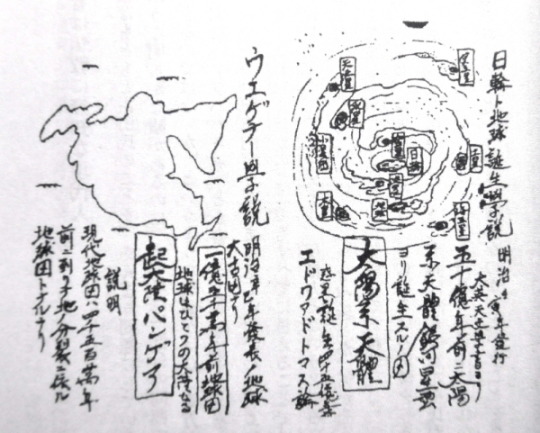
Truth to be told, even without the grand urine discovery, TSS was not difficult to discard as a forgery. As I mentioned above, its particular weakness are bizarre references to scientific concepts and discoveries, revealing a low level of historical awareness of the author – for example, references are made to quasars, continental drift theory and Pluto – discoveries not yet made in the suggested eras; to make it more embarrassing, TSS claims it was based on foreign sources which weren't yet published at the listed dates. It also references natural disasters which never happened, and urban legends and folklore which only developed recently, like the claims about Jesus' grave being located in Aomori prefecture, which only date back to the 1930s (Wada's documents claimed it was a story already known in the Kansei period, in the 1790s...). On top of all of this, a number of purported authentic illustrations were simply traced from contemporary sources:

It's worth noting that TSS wasn't the only fraud Wada was involved in, as we can learn from his wikipedia biography he fraudulently claimed to be a former Imperial Palace escort officer before embarking on his adventure with crafting false chronicles soaked in urine. Tragically, TSS found supporters not only among the expected crowd of various wannabe occultists, frauds and naive teenagers, but also among a number of genuine historians, most notably Takehiko Furuta. It would appear that he became interested in it in hopes of finding support for his theories about Japan originally having more than one ruling family, but with time he fully embraced it, and actively advocated the bizarre visions it contained. A particularly outlandish claim of his was insisting that Meiji era educator and political activist Fukuzawa Yukichi quoted TSS in his work (the quote in mention appears to be a paraphrase from american declaration of independence). It's worth noting that while Furuta seemingly was a genuinely accomplished scholar of Shinran doctrine, supporting TSS was far from his only adventure with pseudohistory. He was also a staunch believer in the long discredited claims about links between japanese Jomon culture and the Valvidia culture of Ecuador, claiming that various references to fantastical lands lying between China and Japan or beyond Japan prove that the Japanese reached America in ancient times (you can torment yourself with one of such articles here). This theory was briefly advocated by a number of American scholars before him, but obviously has no support today. It's nothing but a new take on XVIIIth century French claims about present day British Columbia being the Fusang described in some Chinese texts. Sometimes strange lands and creatures at the edge of the map are nothing more but fantasy. Furuta's particularly shameful contribution to TSS discourse was declaring that undermining its authenticity is rooted in historical prejudice against the inhabitants of Tohoku and Hokkaido. Personally I'm under the impression that discarding an entire region's real, very complex history in favor of fanciful hoaxes is much more likely to be rooted in such prejudice. The claim Arahabaki was an Ainu kamuy, common online, appears to come from a similar place – I will not examine it here, but I find attempts to shield forgeries from criticism by attaching them to poorly documented and historically suppressed beliefs of historically persecuted groups to be even more disgusting than regular fraud of this sort. What Arahabaki actually is? This is difficult for me to tell for sure, but certainly nothing out of ordinary - not a dogu, and not the main figure of some lost fabulous country. There is a number of mundane temples enshrining Arahabaki, for example here. This article also mentions a number of mundane locations enshrining Arahabaki today; curiously, many of them are located outside Tohoku. A number of theories exist, linking Arahabaki to the usual suspects: religious beliefs of the Emishi people, who originally inhabited Tohoku, and may or may not be one and the same as ancestors of present day Ainu; snake worship; ironworking traditions; marebito beliefs; gods enshrined in freshly established fortresses... Whatever the truth is, it will inevitably turn out to be more interesting than hoaxes, as study of history generally proves.
323 notes
·
View notes
Text
Whenever I visit Olvera Street, as I did a couple of weeks ago, my walk through the historic corridor is always the same.
Start at the plaza. Pass the stand where out-of-towners and politicians have donned sombreros and serapes for photos ever since the city turned this area into a tourist trap in 1930.
Look at the vendor stalls. Wonder if I need a new guayabera. Gobble up two beef taquitos bathed in avocado salsa at Cielito Lindo. Then return to my car and go home.
I’ve done this walk as a kid, and as an adult. For food crawls and quick lunches. With grad students on field trips, and with the late Anthony Bourdain for an episode of his “Parts Unknown.”
This last visit was different, though: I had my own camera crew with me.
My last chance at Hollywood fame was going to live or die on Olvera Street.
I was shooting a sizzle reel — footage that a producer will turn into a clip for television executives to determine whether I’m worthy of a show. In this case, I want to turn my 2012 book “Taco USA: How Mexican Food Conquered America” into the next “Diners, Drive-Ins, and Dives.” Or “Somebody Feed Phil.” Or an Alton Brown ripoff. Or a TikTok series.
Anything at this point, really.
For more than a decade, I’ve tried to break into Hollywood with some success — but the experience has left me cynical. Personal experience and the historical record have taught me that studios and streamers still want Mexicans to stay in the same cinematic lane that American film has paved for more than a century. We’re forever labeled… something. Exotic. Dangerous. Weighed down with problems. Never fully developed, autonomous humans. Always “Mexican.”
Even if we’re natives of Southern California. Especially if we’re natives of Southern California.
I hope my sizzle reel will lead to something different. I doubt it will because the issue is systemic. Industry executives, producers, directors and scriptwriters can only portray the Mexicans they know — and in a perverse, self-fulfilling prophecy, they mostly only know the Mexicans their industry depicts even in a region where Latinos make up nearly half the population.
The vicious cycle even infects creators like me.
As the film crew and I left for our next location, I stopped and looked around. We were right where I began, except I now looked south on Main Street. The plaza was to my left. City Hall loomed on the horizon. The vista was the same as the opening scene of “Bordertown,” a 1935 Warner Bros. film I had seen the night before. It was the first Hollywood movie to address modern-day Mexican Americans in Los Angeles.
What I saw was more than déjà vu. It was a reminder that 86 years later, Hollywood’s Mexican problem hasn’t really progressed at all.
Birth of a stereotype
Screen misrepresentation of Mexicans isn’t just a longstanding wrong; it’s an original sin. And it has an unsurprising Adam: D.W. Griffith.
He’s most infamous for reawakening the Ku Klux Klan with his 1915 epic “The Birth of a Nation.” Far less examined is how Griffith’s earliest works also helped give American filmmakers a language with which to typecast Mexicans.
Two of his first six films were so-called “greaser” movies, one-reelers where Mexican Americans were racialized as inherently criminal and played by white people. His 1908 effort “The Greaser’s Gauntlet” is the earliest film to use the slur in its title. Griffith filmed at least eight greaser movies on the East Coast before heading to Southern California in early 1910 for better weather.
The new setting allowed Griffith to double down on his Mexican obsession. He used the San Gabriel and San Juan Capistrano missions as backdrops for melodramas embossed with the Spanish Fantasy Heritage, the white California myth that romanticized the state’s Mexican past even as it discriminated against the Mexicans of the present.
In films such as his 1910 shorts “The Thread of Destiny,” “In Old California” (the first movie shot in what would become Hollywood) and “The Two Brothers,” Griffith codified cinematic Mexican characters and themes that persist. The reprobate father. The saintly mother. The wayward son. The idea that Mexicans are forever doomed because they’re, well, Mexicans.
Griffith based his plots not on how modern-day Mexicans actually lived, but rather on how white people thought they did.
A riot nearly broke out as Latinos felt the scene mocked them. It was perhaps the earliest Latino protest against negative depictions of them on the big screen.
But the threat of angry Mexicans didn’t kill greaser movies. Griffith showed the box-office potential of the genre, and many American cinematic pioneers dabbled in them. Thomas Edison’s company shot some, as did its biggest rival, Vitagraph Studios. So did Mutual Film, an early home for Charlie Chaplin. Horror legend Lon Chaney played a greaser. The first western star, Broncho Billy Anderson, made a career out of besting them.
These films were so noxious that the Mexican government in 1922 banned studios that produced them from the country until they “retired... denigrating films from worldwide circulation,” according to a letter that Mexican President Álvaro Obregón wrote to his Secretariat of External Relations. The gambit worked: the greaser films ended. Screenwriters instead reimagined Mexicans as Latin lovers, Mexican spitfires, buffoons, peons, mere bandits and other negative stereotypes.
That’s why “Bordertown” surprised me when I finally saw it. The Warner Bros. movie, starring Paul Muni as an Eastside lawyer named Johnny Ramirez and Bette Davis as the temptress whom he spurns, was popular when released. Today, it’s almost impossible to see outside of a hard-to-find DVD and an occasional Muni marathon on Turner Classic Movies.
Based on a novel of the same name; Muni was a non-Mexican playing a Mexican. Johnny Ramirez had a fiery temper, a bad accent and repeatedly called his mother (played by Spanish actress Soledad Jiminez ) “mamacita,” who in turn calls him “Juanito.” The infamous, incredulous ending has Ramirez suddenly realizing the vacuity of his fast, fun life and returning to the Eastside “back where I belong ... with my own people.” And the film’s poster features a bug-eyed, sombrero-wearing Muni pawing a fetching Davis, even though Ramirez never made a move on Davis’ character or wore a sombrero.
These and other faux pas (like Ramirez’s friends singing “La Cucaracha” at a party) distract from a movie that didn’t try to mask the discrimination Mexicans faced in 1930s Los Angeles. Ramirez can’t find justice for his neighbor, who lost his produce truck after a drunk socialite on her way back from dinner at Las Golondrinas on Olvera Street smashed into it. That very socialite, whom Ramirez goes on to date (don’t ask), repeatedly calls him “Savage” as a term of endearment. When Ramirez tires of American bigotry and announces he’s moving south of the border to run a casino, a priest in brownface asks him to remain.
“For what?” Ramirez replies. “So those white little mugs who call themselves gentlemen and aristocrats can make a fool out of me?”
“Bordertown” sprung up from Warner Bros.’ Depression-era roster of social-problem films that served as a rough-edged alternative to the escapism offered by MGM, Disney and Paramount. But its makers committed the same error Griffith did: They fell back on tropes instead of talking to Mexicans right in front of them who might offer a better tale.
Just take the first shot of “Bordertown,” the one I inadvertently recreated on my television shoot.
Under a title that reads “Los Angeles … the Mexican Quarter,” viewers see Olvera Street’s plaza emptier than it should be. That’s because just four years earlier, immigration officials rounded up hundreds of individuals at that very spot. The move was part of a repatriation effort by the American government that saw them boot about a million Mexicans — citizens and not — from the United States during the 1930s.
Following that opening shot is a brief glimpse of a theater marquee that advertises a Mexican music trio called Los Madrugadores (“The Early Risers”). They were the most popular Spanish-language group in Southern California at the time, singing traditional corridos but also ballads about the struggles Mexicans faced in the United States. Lead singer Pedro J. González hosted a popular AM radio morning show heard as far away as Texas that mixed music and denunciations against racism.
By the time “Bordertown” was released in 1935, Gonzalez was in San Quentin, jailed by a false accusation of statutory rape pursued by an L.A. district attorney’s office happy to lock up a critic. He was freed in 1940 after the alleged victim recanted her confession, then summarily deported to Tijuana, where Gonzalez continued his career before returning to California in the 1970s.
Doesn’t Gonzalez and his times make a better movie than “Bordertown”? Warner Bros. could have offered a bold corrective to the image of Mexican Americans if they had just paid attention to their own footage! Instead, Gonzalez’s saga wouldn’t be told on film until a 1984 documentary and 1988 drama.
Both were shot in San Diego. Both received only limited screenings at theaters across the American Southwest and an airing on PBS before going on video. No streamer carries it.
How Hollywood imagines Mexicans versus how we really are turned real for me in 2013, when I became a consulting producer for a Fox cartoon about life on the U.S.-Mexico border.
The title? “Bordertown.”
It aired in 2015 and lasted one season. I enjoyed the end product. I even got to write an episode, which just so happened to be the series finale.
The gig was a dream long deferred. My bachelor’s degree from Chapman University was in film. I had visions of becoming the brown Tarantino or a Mexican Truffaut before journalism got in the way. Over the years, there was Hollywood interest in articles or columns I wrote but never anything that required I do more than a couple of meetings — or scripts by white screenwriters that went nowhere.
But “Bordertown” opened up more doors for me and inspired me to give Hollywood a go.
While I worked on the cartoon, I got another consulting producer credit on a Fusion special for comedian Al Madrigal and sold a script to ABC that same year about gentrification in Boyle Heights through the eyes of a restaurant years before the subject became a trend. Pitch meetings piled up with so much frequency that my childhood friends coined a nickname for me: Hollywood Gus.
My run wouldn’t last long. The microagressions became too annoying.
The veteran writers on “Bordertown” rolled their eyes any time I said that one of their jokes was clichéd, like the one about how eating beans gave our characters flatulent superpowers or the one about a donkey show in Tijuana. Or when they initially rejected a joke about menudo, saying no one knew what the soup was, and they weren’t happy when another Latino writer and I pointed out that you’re pretty clueless if you’ve lived in Southern California for a while and don’t know what menudo is.
The writers were so petty, in fact, that they snuck a line into the animated “Bordertown” where the main character said, “There’s nothing worse than a Mexican with glasses” — which is now my public email to forever remind me of how clueless Hollywood is.
The insults didn’t bother me so much as the insight I gained from those interactions: The only Latinos most Hollywood types know are the janitors and security guards at the studio, and nannies and gardeners at their homes. The few Latinos in the industry I met had assimilated into this worldview as well.
Could I blame them for their ignorance when it came to capturing Mexican American stories, especially those in Southern California? Of course I can.
What ended any aspirations for a full-time Hollywood career was a meeting with a television executive shortly after ABC passed on my Boyle Heights script (characters weren’t believable, per the rejection). They repeatedly asked that I think about doing a show about my father’s life, which didn’t interest me. Comedies about immigrant parents are clichéd at this point. So one day I blurted that I was more interested in telling my stories.
I never heard from the executive again.
A pair of boots
Five years later, and that Hollywood dream just won’t leave me.
I’m not leaving journalism. But at this point, I just want to prove to myself that I can help exorcise D.W. Griffith’s anti-Mexican demons from Hollywood once and for all. That I can show the Netflix honcho they were wrong for passing on a “Taco USA” series with the excuse that the topic of Mexican food in the United States was too “limited.” And the Food Network people who said they just couldn’t see a show about the subject as being as “fun” as it was. Or the bigtime Latino actor’s production company who wanted the rights to my "¡Ask a Mexican!” book, then ghosted me after I said I didn’t hold them but I did own the rights to my brain.
When this food-show sizzle reel gets cut, and I start my Hollywood jarabe anew, I’ll keep in mind a line in “Bordertown” that Johnny Ramirez said: “An American man can lift himself up by his bootstraps. All he needs is strength and a pair of boots.”
Mexicans have had the strength since forever in this town. But can Hollywood finally give us the botas?
#mexican#mexican american#chicano#chicana#usa#united states#racism#discrimination#hollywood#movies#history#california#stereotypes#latinos#latinas#ku klux klan#mexico#🇲🇽
3 notes
·
View notes
Text
Dating Disney: Tarzan

Somebody asked me to cover this movie, and considering the annoying fact that people honestly believe the Tarzan/Frozen connection theory to be true, I’m more than ready to nail down every single reason why this movie and Frozen aren’t connected.
Fashion

Tarzan’s mother is wearing her hair in a ringlet ponytail style, which exploded in popularity during the Victorian Era (1837-1901). The father is wearing a simple three piece suit as seen in the official family portrait. Tarzan’s father has the same mustache style as The Grand Duke in Cinderella, an A La Souvarov, named for Alexander Souvarov, a Russian military leader who lived from 1730-1800.

The mother’s dress resembles this one from 1890. Given that Tarzan is about 20 years old and she’s wearing this when he’s a baby, this should place the movie in 1910.
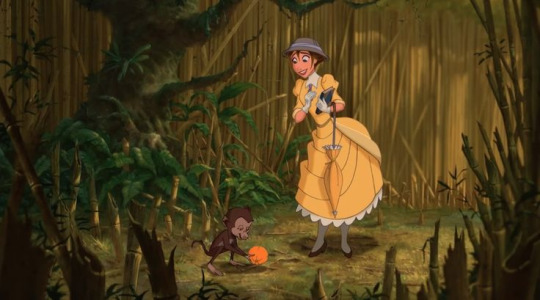
Jane Porter arrives in the Jungle wearing a yellow dress with a prominent bustle which were popular from the 1870s through the 1880s. We can see her wearing short gloves, a collar and ascot of some sort, and what she addresses as her boots, but could potentially be high heel shoes with high spats on them, which emerged in the late 19th century and fell out of fashion in the 1920s.
Technology

Around the human camp, we see many Victorian era inventions. There’s a grandfather clock (invented 1680), a phonograph with a 1907 design, typewriter with a 1911 design, a vanity mirror likely with silvered glass (1835), a blackboard (16th century), a penny farthing bicycle, popular in the 1870s and 1880s, and especially the Magic Lantern, a late 19th century educational tool.
Culture

Jane teaches Tarzan to read English with “See Jane. See Jane Run” an homage to Dick and Jane books used to teach children how to read created by William Scott Gray in the 1930s. Clayton mentions that he taught a parrot to sing “God Save the Queen”, first created in 1745. While flipping through images, we see images of the Statue of Liberty (1886) and the Eifel Tower (1889). When Tarzan agrees to go to England, the Professor and Jane exclaim that many people will want to meet him. Kings, scientists, and famous writers. The professor name drops Darwin, Kipling, and Queen Victoria. He is referring to Charles Darwin (1809-1882), Queen Victoria of England (reign 1837-1901), but the outlier and trouble maker being Rudyard Kipling (1865-1936). If the Professor expects Tarzan to meet Darwin, then Darwin must still be alive (at least when they leave England) but they’re likely not in Africa for more than a year, and even if the movie was set shortly after Darwin’s death, Rudyard Kipling is barely 20 years old himself when Charles Darwin died, and was still in school in the 1880s. His most famous work “The Jungle Book” wasn’t even written until 1894, twelve years after Darwin’s death.
Biology
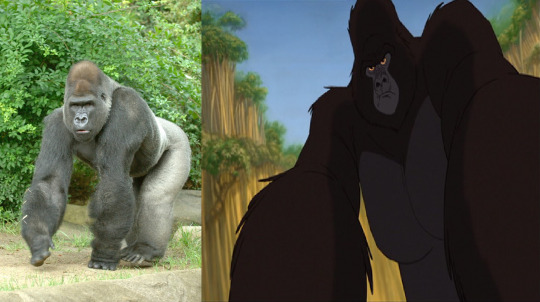
The gorilla seen in the film seem to resemble the Western Lowland Gorilla (Gorilla gorilla gorilla). Yes, that’s the real scientific name for this subspecies.
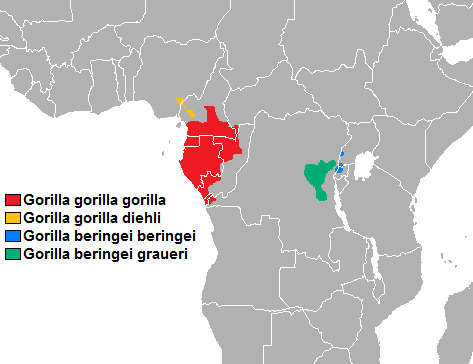
The Western Lowland Gorilla is native to Cameroon, Equatorial Guinea, Gabon, and the Republic of the Congo. They are also touch slightly into Central African Republic and Democratic Republic of the Congo, but neither of those countries are coastal, and Tarzan clearly takes place in a coastal African rain forest with Western Lowland Gorilla. Jane is chased by a troop of Mandrill Baboons whose habitat is nearly identical to the Western Lowland Gorilla. African Elephants are found in the same area, but most abundant in Gabon, and Hippopotamus used to be found all over southern Africa but now only live in scattered clumps. Nile Crocodiles can be found over most of Africa, and in every country where the Western Lowland Gorilla lives. Leopards like Sabor are also native to this region of Africa, but Mound-Building Termites are native to the south and northeastern parts of Africa, and are not in Tarzan’s neck of the rain forest. We see a Rhinoceros sharpening its horn, but Rhinos don’t live or even wander to that part of Africa. The Black-and-White Colobus monkeys we seen in “Son of Man” are not direct neighbors of Tarzan, but live close enough that him running into them isn’t too far fetched.

While searching for Gorillas, Professor Porter mentions heading west, following the Ganoderma Applanatum, a large fungus that grows on trees. However, it’s clear the Professor doesn’t always know what he’s talking about. When Jane is describing the baboon chase to her father, he cites them as being Theropithecus Baboonus, a scientific name that doesn’t exist, and the only animals with Theropithecus are all extinct.
Conclusion

Due to Professor Porter expecting Tarzan to meet Charles Darwin, the Porter party must have left England in, before, or shortly after 1882 when he passed away. Because of the equatorial rain forest climate, it’s hard to tell the passage of time. They could have been in Africa for a week, a month, or a year. Aside from characters not visibly aging there’s nothing we can really go by in terms of time frame. But unless they’ve been in the jungle for a decade, the Professor would likely know that Darwin was dead before the 1890s. This strongly indicates an 1882 to 1883 time frame. There’s definitely a lot of technological and fashion anachronisms in this movie, but the clearly defined lifespans of real people makes placing an era easier.
Setting: West Coast of Subsaharan Africa Year: 1882-1883 Period: Victorian (1837-1901) Language: English Tarzan’s Birth: Approx. 1862-1864
#dating disney#disney#tarzan#jane porter#professor porter#archimedes q porter#clayton#kala#kerchak#tantor#terk#africa#victorian#19th century#gorilla#rain forest#disney jane#disney tarzan#disney renaissance
567 notes
·
View notes
Text
If you’d like to write the Goldsteins as Jewish (since they are!) but aren’t sure how to do that, I’ve compiled a list of fiction books about early-twentieth-century American Jewish life! I figured that nonfiction can be hard to access or get through, and info sites like MyJewishLearning are hard to contextualize both into actual experiences and into the historical setting. Plus, fiction gives you a feel for things rather than just tossing information at you. And it’s enjoyable! These books can help you learn about what Tina and Queenie’s upbringing and lifestyle might have been like, and they go into topics like food, tenement life, Jewish neighborhoods, school, social/love lives, religious and cultural life, and how Jews adjusted from being new immigrants to being more integrated into general society. They’re from slightly different time periods, and all but one take place in New York City.
The Boston Girl by Anita Diamant
Era: 1915-1930
Coming of age story of a young woman named Addie, featuring her friendships, family struggles, love life, and career misadventures. Addie was born around 1901, so she’s a good reference for Tina. It’s a useful book for this since it spans such a large range of time. It goes into details about things like language, culture, tenement life, settlement houses, employment, religion, food, weddings, and other life cycle rituals. It does take place in Boston, rather than NY, but I imagine there were a lot of similarities.
The Golem and the Jinni by Helene Wecker
Era: 1899/1900
A really lovely fantasy book about a golem (a creature from Jewish folklore) and a Jinni who find themselves in New York City and strike up a frienship. The Golem, Chava, lives in the Jewish area of the city and follows Jewish customs. This is a little before Tina and Queenie’s time, but it could be a good reference for their parents and for understanding the environment they may have come from. It goes into local flavor, different types of Jews (religious vs. secular), and how the community works. It also goes into Jewish magic stuff!
The Amazing Adventures of Kavalier & Clay by Michael Chabon
Era: 1930s/40s
Joe Kavalier is a talented artist from Prague who escapes pre-Holocaust Europe in a box, and Sammy Clay, his cousin, is an American Jew who knows how to turn dreams into entrepreneurship. Together, they use their creativity and ingenuity to break into the emerging comics industry based in NYC. It also gives insights into what secular Jewishness would have looked like and how it was still undeniably Jewish, in a much better way than I can describe in tumblr posts (it helps that the author is a secular Jew himself, whereas I’m religious).
Middle-grade books - I’m including these even though they’re for kids because they’ve got good information, and they’re good if you’re looking for a faster read. Also, if English isn’t your first language and you want something easier, these are a good choice.
All-of-a-Kind-Family by Sydney Taylor
Era: 1910s
This is a set of five books about five sisters growing up on the Lowest East Side of NYC. It goes into tenement life, the Jewish community, religious life, corner stores, chores, social lives, school, Shabbat, etc. It could be a good reference for Tina and Queenie’s childhoods. The author herself was actually born in 1904, and the stories are based on her own upbringing, not just research.
Rebecca: The Sound of Applause
Era: 1914
This is an American Girl book about a ten-year-old girl named Rebecca. It goes into school life, religious life, the fabric of the neighborhood, the differences between new and recent immigrants, and dealing with Christmas. Also a good reference for Tina and Queenie’s childhoods.
Dave at Night by Gail Carson Levine
Era: 1926
Dave is eleven when his father dies and he’s sent to live at a Jewish boys’ orphanage. But he starts sneaking out at night, and an old man takes him under his wing and starts bringing him to parties. He lives a dull orphanage life by day and an exciting Harlem Renaissance life by night. Dave is younger than the Goldstein girls, but since it takes place in 1926 I thought I’d include it anyway. It goes into Jewish mourning practices, Jewish communal life, and some of the ways Jews interacted with other communities.
Hope these are useful! I recommend them all just as books to read for pleasure, btw, in addition to references.
#fantastic beasts#tina goldstein#queenie goldstein#goldstein sisters#jewish goldsteins#newtina#jaqueenie#jakweenie#fantastic beasts and where to find them#fantastic beasts the crimes of grindelwald
123 notes
·
View notes
Text
Merlin Writer Month: Faves Week
So, I’ve been really looking forward to this week and I have a ton of recommendations. Hope I provide you with something new and that you enjoy it! This are in no particular order, they are just works that I love in equal measure for different reasons and that I feel everyone should read because they are amazing. Also, this is going to be long, so sorry (but not really) about that, so you’ll find everything after the cut.
Also, if the fic has a “*” beside it, it means it is a restricted work on AO3, so you’ll need to be logged in to read it.
The thing is, I need to start this list by putting my absolute favorite at the very beggining. After it, as I wrote above, they’re all equally beloved to me, but this first one is just it for me for various reasons.
The Sidewalks of New York by emmbrancsxx0 Lenght: 161,191 Summary: New York City, 1925. Jazz, flappers, parties, and violence. In the midst of Prohibition, crime boss Arthur Pendragon and his gang, the Knights of the Round Table, arrive from London to open a speakeasy in Chelsea. Fearing they’ll lose their hold on Manhattan’s West Side, the Black Kings send Merlin Emrys to spy on the Knights. The two gangs quickly become rivals, and there is no place for love in war.
Comment: This fic is just absolutely brilliant in every sense. It picked my interest because of the time it is set in (which is my favorite time in history). I’ve always had a fascination with New York 1910-1930 and the whole Prohibition and gangs aspect of it. This is just so well balanced in every aspect that it offers: the romance, the betrayals, the rivalries between gangs, the characters and their personalitites and motivations are just fantastic. Arthur as a crime boss is just delightful as is Merlin as the charismatic bartender of the speakeasy (even tho he is so much more than that). It’s tense, it’s violent, it’s romantic and it has a happy ending, what more could I ask for? This author writes so freaking amazing and I love everything she’s written so if you like this one, you should totally check out all her other stuff because it’s just as amazing. Also, Arthur is known as the “Golden Knight” and for some reason that just made me love it even more. Arthur and Merlin are brilliant and she just gets the point across so well of how much they love and get each other and that’s one of the reaons why I love it so much, it’s just... they belong together and I love the journey (the hearthache and the love and everything in between) until they get to the point of actual happiness and understanding.
1. True North by Kroki_Refur * Lenght: 6,752 Summary: Arthur is given a compass that is unable to tell north from south, but always points him to where Merlin is.
Comment: Oh, this fic. It follows Arthur and Melrin throughout the centuries, with Arthur always finding his way to Merlin. Soulmate-y of sorts and just lovely in the way this gets the point across that they belong together and that they’ll always find each other.
2. The Reincarnation Situation by orphan_account Lenght: 16,591 Summary: My series finale gift to the Merlin fandom. Reincarnation. Merlin and Arthur only remember their past lives for one night a year - New Year's Eve. This is a quick tour (and it's not cracky like the title suggests, I swear). Merlin still thinks that perhaps the dragon was right and one day Arthur will return as a king destined to save the people of Albion, but that day has not yet come. Arthur has not missed a single moment of life since Merlin laid him to rest in the waters of Avalon but the lives he has lived have not been for his people or for the greater good, they have been just for Merlin.
Comment: SO, SO, SO much love for this one. Again, anothe bitter-sweet read but so worth it, it tugs at your heart but comforts you in the knowledge that they’ll always have each other. Fantastic narrative and I love each of the reincarnations shown. It also has a lovely podfic. Soulmates is something I’ve always been a sucker for and this fic is amazing in how it portrays them througout time and the intensity of remembering for one night, who they really are.
3. Tulips Are Better; Dragons Are Best by sweetiejelly Lenght: 58,627 Summary: Arthur loses a bet with Morgana and ends up on The Bachelor. As he identifies as bisexual, the pool of candidates is quite diverse and includes one Merlin Emrys, his ex. Arthur thinks it's fate. Merlin thinks it's bollocks. Thus begins (again) their courtship.
Comment: So delightful and fun and angsty. Arthur’s complete dismissal of anyone that isn’t Merlin is just so fun to read, how he wants to just send everyone home as soon as he realizes Merlin is there is just hilarious and shows how gone he is. A Modern AU with magic with boths sides wanting each other but with issues that need talking over and mending before they get together and Merlin’s magic being as in love with Arthur as he is, is just one of the things that make me love this as much as I do. Stupid and stubborn boys make my heart melt with their longing. The art is so lovely and adds so much to it. Read it, it’s fantastic.
4. You bring music to my silent world by Balthamos Lenght: 49,818 Summary: Arthur and Merlin are thrown together as children when Merlin’s mother moves into the Pendragon Manor as the new housekeeper, bringing her deaf son Merlin with her. Arthur is a loud and obnoxious child, whereas Merlin is quiet but not as shy as everyone thinks. The two children become fast friends, but as they grow up together things begin to change, due to the pressure of wanting to be normal, and the growing lack of communication between the pair. Growing up is never easy and the graceful friendship they had as children gets lost as they reach their teenage years, but through their difficulties they develop a deeper, stronger relationship, one far more permanent.
Comment: I love, love, love, love this one. Like anything by this author is amazing, so you should totally check them out if you haven’t, but this one, gosh, it’s so lovely it hurts.
5. Where the Hurt Is by undersomestairs Lenght: 12,349 Summary: For this Kink Me! Merlin prompt: They were childhood/teenage sweethearts but Arthur's family moved away (because Uther detested Merlin but Arthur doesn't know this) and they promise to write. After Uther's death Arthur finds all the letters from Merlin he never received. All the time he thought Merlin had forgotten him. Arthur seeks him out.
Comment: Oh my god, this one made me cry. It takes your heart and stomps on it and then mends is back but not before it kind of destroys you. How you see Merlin losing hope, Arthur’s feelings after he realized Merlin didn’t forget him but that it was Uther and then his sorrow over what he thinks lost. Read it, it’s just beautiful.
6. License to Thrill by lady_ragnell Lenght: 14,174 Summary: Merlin's employees bet him the recipe for the most addictive cocoa in the world that he can't find out what the hot blond who comes into his chocolate shop does for a living within the month. He ends up getting far more than he bargained for.
Comment: Arthur as James Bond (kind of) and Merlin as the chocolatier who steals his heart via his sweet tooth and shameless flirting from Arthur’s part because Merlin is lovely. So incredibly good and it has a podfic by wildwildwoods which is also incredibly lovely. Read/listen to it, you’lll feel better after.
7. Remember, Remember by winterstorrm Lenght: 16,480 Summary: Prince Arthur gives up the person he loves to do his duty, but Merlin's impossible to forget.
Comment: So, anything by this author is amazing (please, check out all of their other stories because they’re fantastic), but this one just breaks my heart. Arthur’s longing and regret is so palpable through every word. His love for Merlin is just so big and I always love to read something where I get to see how much Arthur feels for Merlin, how much Merlin means to him, how much he loves and needs Merlin.
8. Mr. & Mr. Smith Series by Detochkina * Lenght: 101,837 Summary: Merlin Emrys is used to living life on the go. As an agent for the Agency of Magic, Merlin’s days are consumed by travel, exotic locations, and battling a faceless rival -- an officer from the competing Bureau of Corrections, who is always hot on his heels and ready to one-up him. When Merlin is sent on a mission to Las Vegas to secure a powerful artifact, he allows himself one night off. Just one, because he bloody deserves it. Drinks and foreplay lead to a bet with a hot financial advisor he just met. Merlin ends up as a newlywed. Oops.
Comment: This series has a special place in my heart because apart from being so bloody good it made my head spin and has me (still because it’s a WIP) on the edge of my seat, I was actually in Vegas and stayed in the hotel in which Arthur and Merlin are in the first two installments. Being able to read while on the locations described in it, made me feel an even bigger connection with the world. This is an absolutely addicting read that before you know it you’ll have read the 5 available works and will be eagerly awaiting the next.
9. So Are They All, All Honourable Men by seperis Lenght: 18,199 Summary: Considering Arthur's future wife will be chosen less for compatibility than for her political value, Merlin may be the only marriage he'll have that won't end in bloodshed or a great deal of fortifying wine.
Comment: Lovely, so very, very, lovely. SO many great lines and the old married couple dynamic and them being so in love is just brilliant. Canon Era, Magic Reveal and lots of love and pinining and getting together. Please do yourself a favor and read it if you haven’t, and if you have, do it again because it’s just amazing. There are moments here in which their love and worry is so palpable it hurts, I love it so much.
10. Oscilliate Wildly by suntipped Lenght: 11,246 Summary: Fucking Arthur, he thinks, pushing his head against the seat. It’s not so much that he’s breaking promises left and right by bringing up that thing between them in public again; it's just his ever-irritating sense of entitlement. It’s Arthur being a prick and thinking he can go around doing anything he wants sometimes, because obviously, obviously the entire world exists only to amuse him.
Comment: This is just one of my all time favorite fics ever. Oblivious, pining boys in love are my favorites. Also, pet-names. A lovely Modern AU with stupid boys who won’t talk to each other. I read this at least 3 times a year, yes, I love it that much.
11. These Feathered Breaths (a Handfasting remix) by Emjayelle Lenght: 3,580 Summary: There was at least a dozen reasons why Arthur, Prince of Wales, couldn't marry Merlin, bird-whisperer, but it didn't stop him from thinking it was the best idea in the world.
Comment: This is one of the most romantic, heart-wrenching and loved filled reads I’ve ever encountered. It’s so insanely beautiful and it tugs on my heartstrings because of the absolute love, devotion and longing that fills each word. The knights as little robins is one of the most adorable concepts ever and if there’s something I love is seeing Arthur not being able to cope with how much he loves Merlin and this conveys it in such a way that it puts fairytales to shame.
12. We Pull These Jobs To Make A Little Money (No One Gets Hurt If They Don’t Act Funny) by leashy_babes Lenght: 48,918 Summary: Arthur and his friends have been making their money this way for years. It's all they know and they're good enough to get away with it. Merlin grudgingly works in a bank, wishing his days away. Their worlds collide and everything changes.AKA: Bank robbers of the round table.
Comment: Arthur is so smitten with Merlin he almost forgets what he actually was there to do. If you haven’t noticied, besotted!Arthur is one of my most favorite things ever and this nails it. I love the concept and the development is fantastic, please read it if you haven’t it’s such an entertaining and lovely read and I love it a lot.
7 notes
·
View notes
Note
What are your favorite fashion trends from the past?
I made a list of 10 things because it makes me feel like watchmojo. I love most (if not all) fashion trends in Chinese history so these aren’t my “favorite” per se, just ones that I think about a lot or are iconic. Everything is womenswear because I don’t know anything about how men dressed (which is also the only reason why I still present femme, on a tangent).
1. Geometric/abstract trim from the Belle Époque
The 1890s and 1900s are two of my favorite decades within the Qing Dynasty, and a big reason for that is the funky geometric trims used on aoku at the time. Whereas the mid 19th century was dominated by complicated trims like prefabricated embroidery pieces, colorful binding, lace and beaded braids, the 1890s saw a shift to plain trims of varying widths applied to form patterns.

Source

Source

Source
(The armpit stains on this one skdjflskdjflkjdf but yeah understandable)
2. Short sleeves of the 1910s
In the 1910s there was this trend of shortening the sleeves of the robe to reveal the long sleeves of the shirt underneath. The sleeve cuffs could get quite decorative and frilly, with ruffles or trimmings. It was the beginning of the process to shorten the sleeves on women’s clothing in the Republican era, yet it somehow harks back to the clothing styles of the 1820s and 30s. I don’t even know if it looks good to the average person but I think it’s layered and very cool.
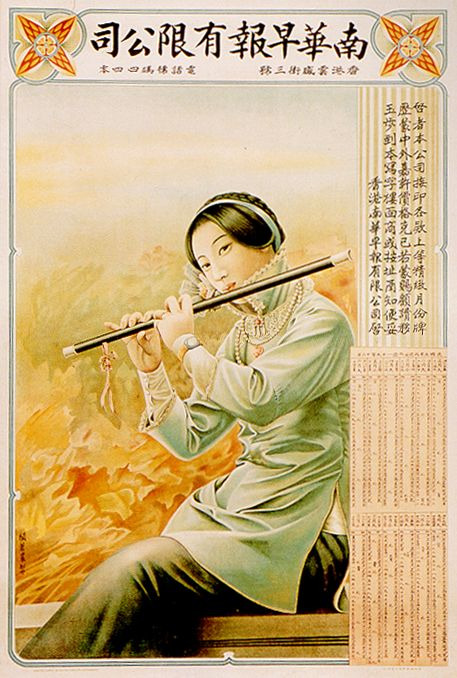
Source
Artwork by 关蕙农 ca. 1916.

Source
Photograph ca. 1915.

Source
Closeup of a Daoguang era painting, showing similar robes with short sleeves.
3. “Paddy field” pattern in the early and mid Qing
Allegedly inspired by the robes of late Ming Taoist nuns (bhikkhuni’s), the “paddy field” or 水田衣 shuitianyi patchwork pattern became popularized in the early and mid Qing in women’s outerwear and survived into the 20th century in children’s clothing. There were quite a lot of 披风 pifeng and 褙子 beizi with paddy field patterns from the 17th and 18th centuries and I think they’re very futuristic and cool.


Source see watermark
Paintings from the the early and mid Qing.
4. Long black skirts of the 1920s
An iconic component of the 文明新装 aoqun look, black skirts pleated or gathered around the waist and adorned with optional flower trim at the bottom. The length and shape differed depending on the specific year, being longer and more bell shaped in 1927-28, more straight cut in 1920-22 and more A line in 1923-26. The black color and minimal use of decoration makes the skirt style very sleek and practical in my opinion, though 20s skirts in general were very cool, not just the black ones.

Source
Early 20s black skirt.

Source
Mid 20s black skirt.
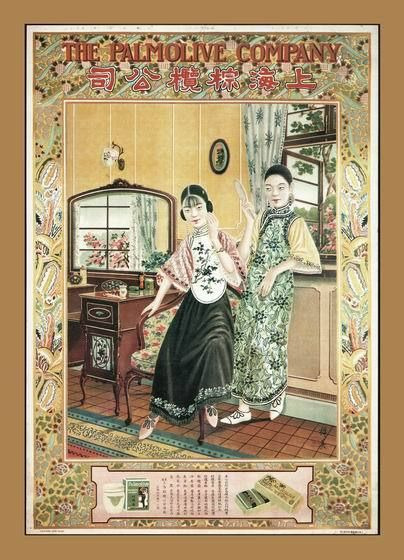
Source
Late 20s black skirt.
5. 1930s cheongsam with two rows of binding
A classic of the mid 1930s. The two rows of wide, shiny binding makes a floor length cheongsam look clean and sleek, especially great when paired with a tall collar and a lacy petticoat.
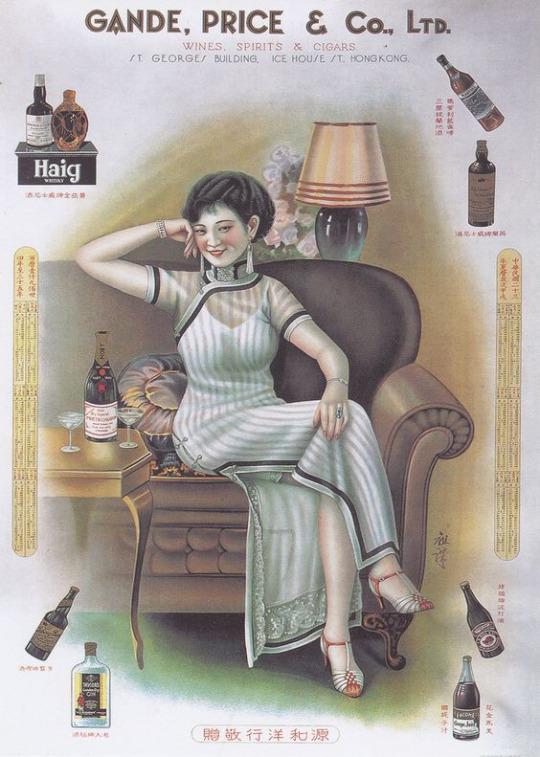
Source here
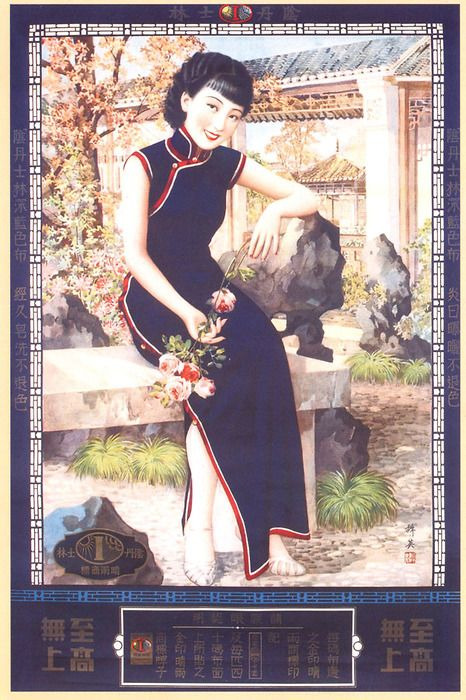
Source here

Source here
Ruan Lingyu <3
6. Puffy skirts of the late 15th century
I have a whole post about them here. Basically puffed up skirts supported by stiff undergarments were quite popular in the 1470s and 80s, creating a “pyramid” shape when combined with the short robe and conical diji. I think this look was very cool and unique and a great example of an historical Chinese fashion trend imported from another country (Korea).
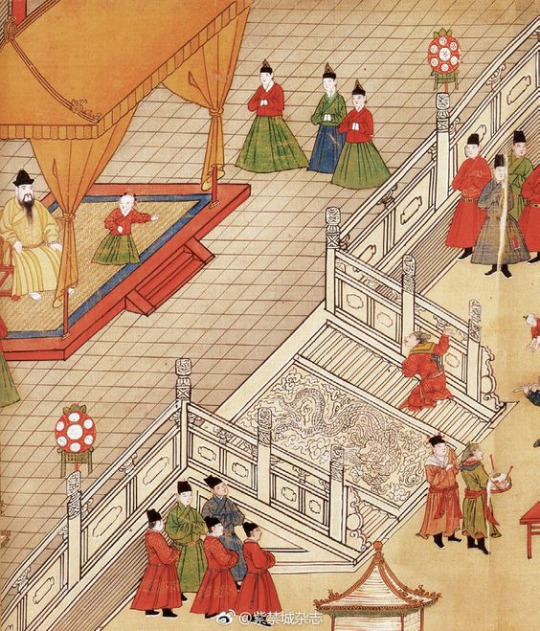
Source see watermark
Closeup of 明宪宗元宵行乐图 (Lantern Festival follies at the Chenghua court) from 1485.
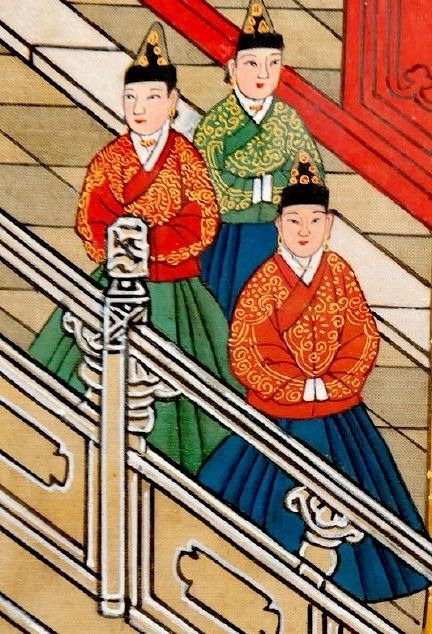

Source
More closed-up closeups.
7. Flapper dresses of 1929-31
This short lived trend for short, skimpy dresses covering the 20s to 30s transition is honestly one of my favorite silhouettes in 20th century Chinese fashion history, it was so unique and underrated. In addition to looking sleek and avant garde, the buck wild Expressionist/Art Deco/Modernist decorations applied to those dresses never cease to entertain me. They might not be the most elegant or conventionally beautiful thing but they’re definitely super fun.
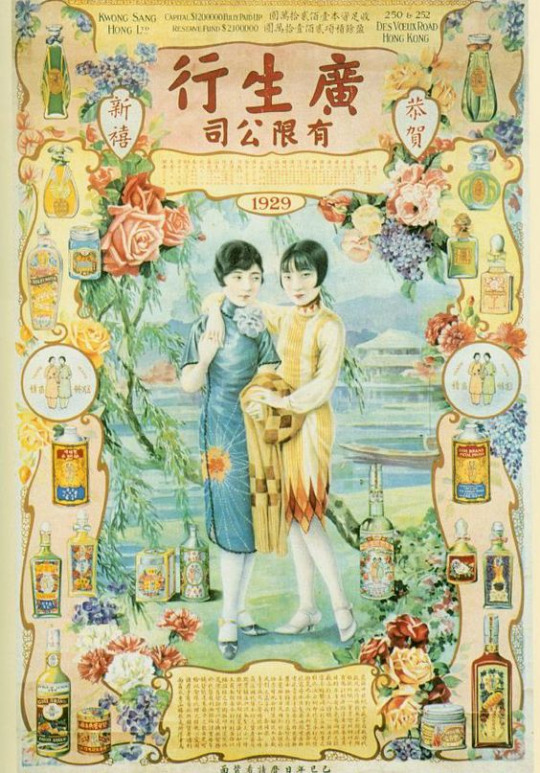
Source
Kwong Sang Hong poster 1929.
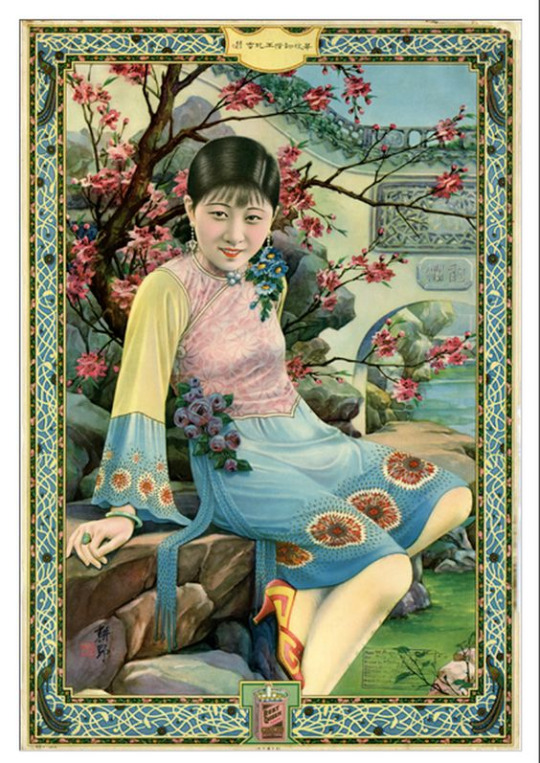
Source

Source

Source
8. Hong Kong style cheongsam of the 1950s and 60s
The adoption of Western bullet or cone or torpedo or whatever you like to call them bras revolutionized cheongsam tailoring, changing from Chinese flat tailoring to Western shaping with darts and pattern pieces. The smooth but angular lines and perfect fit of a Hong Kong style cheongsam is very satisfying to me. The extreme hourglass New Look silhouette was, well, extreme, and I personally find it a lot bolder and more adventurous than 21st century cheongsam which tries to be form fitting but doesn’t even dare to use shapewear. I’m really not a fan of modern cheongsam makers making cheongsam super tight to show off the figure of the model, I don’t think it’s very graceful. It’s even more ridiculous when the cheongsam maker tries to justify that by saying they’re “modernizing” cheongsam and making it more shapely; in that category, people from 60 years ago already did better. I feel like many cheongsam makers aren’t aware that instead of making a cheongsam so tight that it could burst at the seams, they could just ask the model to wear a corset and paddings and tailor the cheongsam based on those proportions... Women in 1950s and 60s Hong Kong style cheongsam looked elegant, confident and powerful and fully aware of the function of shapewear, I stan.

Source


Source
9. Giant pompadours of the Kangxi era (1661-1722)
A feral version of the end of Ming 三绺梳头 hairstyle with a very tall and voluminous front. Tall hairstyles have been a thing in many periods in Chinese history (like the Tang I believe?), but not for a long while until the 1660s, so it was quite groundbreaking and interesting at the time. It was also very distinct when coupled with the signature 燕尾 or swallow tail of the period.

Source
《豪家佚乐图》
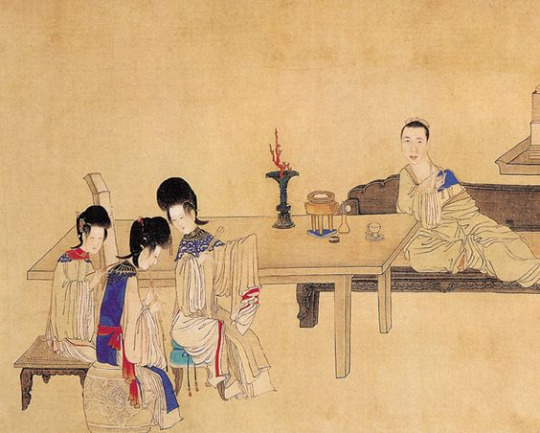
Source
《乔园之三好图》
10. Super tall collars of the early 30s
Popular between roughly 1932-34, there was this trend of adding extremely tall collars to one’s cheongsam, closed by anywhere between three to six buttons. I think these collars elongate the neck very well, despite making it difficult to turn one’s head ahaha.
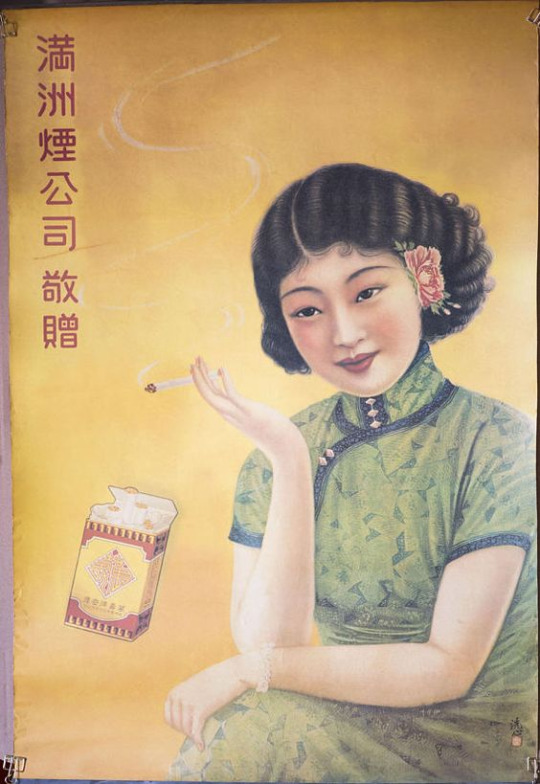
Source
Three buttons

Source
Four buttons

Source
Five buttons
The six buttons is somewhat mythical and I don’t have any images of it at the moment, though I have seen a couple from the early 30s.
Feel free to add to this list your favorite Chinese historical fashion trends <3
209 notes
·
View notes
Photo

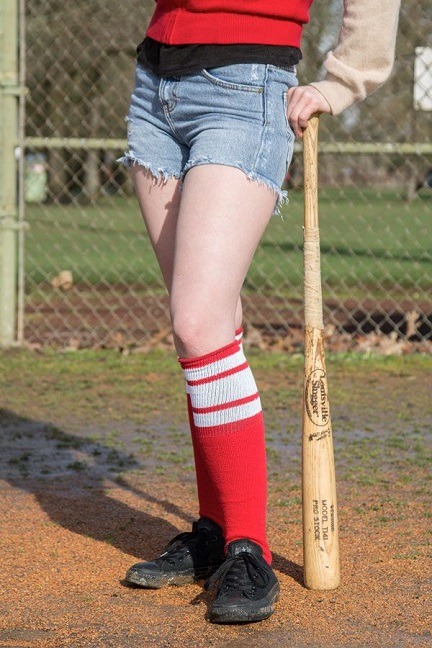

Socks Through Time: History of Top-Stripes
If you've been paying attention to fashion trends for 2018, you may have noticed that top-striped styles are currently a must-have. Being the nerds and amateur historians that we are, we decided to look into the history of this look, and the results were both surprising, and reassuring.
But what is surprising about the history of top-stripes? Well, in this day and age we tend to associate the look with sporty styles, and for most of the 20th century that's really what a top-striped sock was: athletic. However, in our research we were excited to find some super-elegant top striped stockings, such as this beautiful "clocked" style (for more info on clocking, see one of our previous blogs, Historical Costuming Part 2!) from the late 17th century.
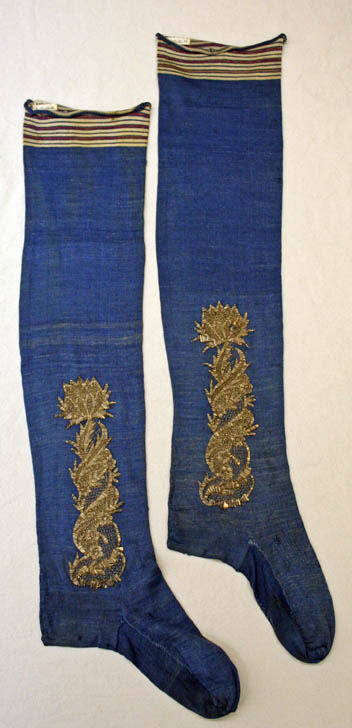
Image under public domain, sourced from metmuseum.org, a Gift of Henri-Marcel Cadgene, 1955
Here the top stripes appear to tie the gold clocked design into the overall composition of the stocking, and may also serve to provide a reinforced/more textured area for era-appropriate ribbon garters to grip, since the blue body of the stocking would have been a fine silk. This is really just an assumption on our part, but we think it's safe to say that these were not intended for athletic wear.
The earliest appearance of something like top-striped athletic socks that our internet sleuthing skills could unearth happens in the 1910's, which seems to be about the time that sports teams began adopting them as uniform socks. Interestingly, the two or three stripes on these styles weren't placed at the very tops of the socks, but when you look at the way the members of the 1912 West Point football team (can you spot the former US President in their line-up?) wear pants that come to just below their knees, overlapping with the tops of the socks, it begins to make sense. In this context, the stripes are about as high up as you can see on the sock, creating the illusion of "true" top-stripes. On the other hand, the North Carolina Tarheels Men's Basketball team of 1911 wore shorts, which gives us a better look at their socks!
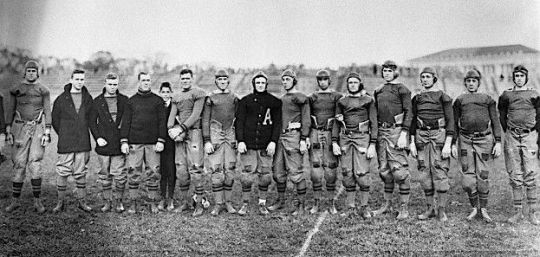
West Point Football Team, 1912. Public Domain via wikimedia commons.
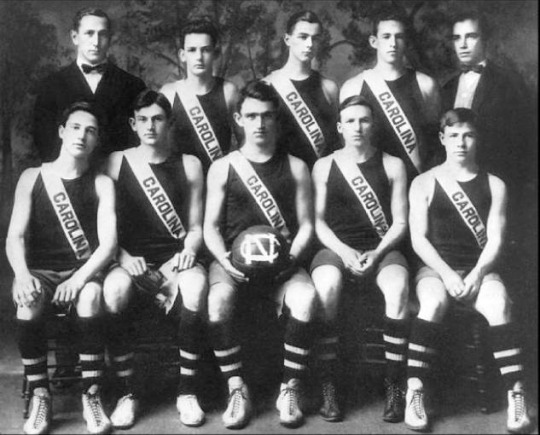
North Carolina Tarheels Men's Basketball Team, 1911. Public domain via wikimedia commons.
But American Football is not the only football at play here, and the top-striped sporty sock style was definitely not confined to the 1910's! Enter Dick, Kerr's Ladies Football Club of Lancashire, England! This team was wildly popular from 1917 until 1965, when women's teams were banned by the Football Association, supposedly because women were too delicate to play sports, but most likely in reality because the women's games regularly outsold the men's games that were held on the same days. While we don't have photographic evidence of every iteration of their uniforms, we have got these lovely photos of their team from the early 1920's sporting thick, ribbed black socks with top stripes, not unlike our Sporty Stripe OTKs!
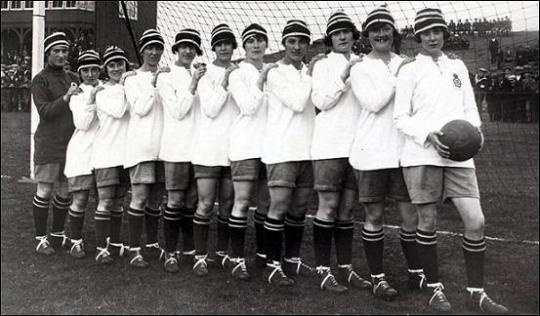
Dick, Kerr's Ladies F. C., 1921. Photo is US public domain, via wikipedia.
For a better look at those nice thick turn-cuff socks, we present you with this (incidentally adorable) photo of the team captains kissing.

The team captains, 1920. Public domain, via wikimedia commons.
Now, some of you sports enthusiasts might be wondering about a certain other ballgame with a long history of sock-related superstition, as well as multiple teams named after socks. If that wasn't enough hints, we're talking about baseball! Though the earliest uniforms used solid colored socks, by the 1930's these sporty little details had worked their way into baseball uniforms too! As you can see from this photo of the American League's 1937 All-Star players, different teams used different numbers of stripes, while the Yankee's stuck with solids (maybe because they're already wearing pinstriped uniforms). Of course the Red Sox are the sock-themed team, so it makes perfect sense that their socks would have the most stripes!
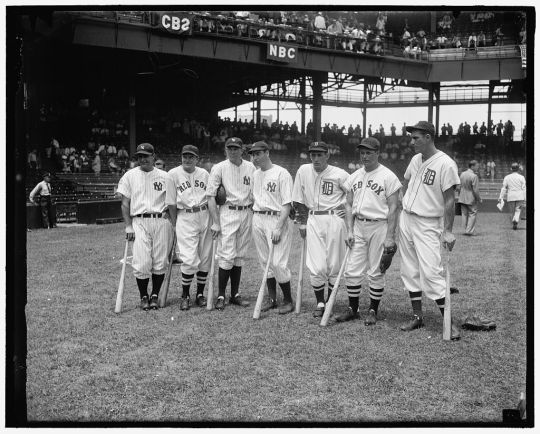
From left to right Lou Gehrig, Joe Cronin, Bill Dickey, Joe DiMaggio, Charlie Gehringer, Jimmie Foxx, and Hank Greenberg. Image sourced via Library of Congress, Harris & Ewing photograph collection.
Taking a closer look at the above image, you might also notice that those socks are lacking certain socky features... things like heels and toes. It appears that these were a sort of stirruped over-sock, which covered the white socks that you can see peeping out of their shoes. While we weren't able to find much information about this particular feature in our researching, our best guess is that this allowed for consecutive wears of the uniform "socks" without washings in-between, as the more generic foot-covering under-socks could be traded out for clean pairs each day -- it's the same reasoning behind this author's love of our Long Cuffable Scrunchable Leg Warmers. It's like my favorite socks, but I can wear them every day for weeks without washing them!
But ball sports weren't the only sports to get in on this trend! What about puck sports? You know, hockey! Introducing the Preston Rivulettes of Canada! We were delighted to discover photos of this women's hockey team in what looks like something akin to our Super Long Ribbed Leg Warmers, only with sporty stripes! Now, like the early rugby socks we looked at, the stripes aren't at the top of the sock (or sock-like garment), but their sparseness is what gives them that distinctly sporty look. Somehow two stripes just looks more aerodynamic than a whole sockful of stripes!

Preston Rivulettes Postcard, 1940. Public domain via Wikimedia Commons.
Now let's get back to football. Or is it soccer? You know -- the one with the spherical ball! Foot(spherical)ball is by far the most popular sport internationally, and like any sport their fans are passionate. We mention this only as framing for the following image, because we want you to really feel the excitement of the moment captured! The year is 1966, and Club Atlético Peñarol of Uruguay has just won the Copa Libertadores de América -- the premier South American football club tournament. Though Peñarol had won the first two editions of the tournament in 1960 and '61, this was their big comeback after other teams took the title in 1962 - '65. You can tell from the spirit of the photo that this was a big moment for the team, as they run across the field celebrating. Possibly even more exciting is the fact that they appear to be wearing almost the exact same socks as the Dick, Kerr's Ladies Football Club circa 1921! To our minds, this firmly places the top striped athletic sock is the Classics category, along with the Doric column.

Club Atlético Peñarol's 1966 Copa Libertadores victory. Public domain, via Wikimedia Commons.
And because we just can't get enough of those groovy soccer uniforms, it's time we took a look at what's been lauded as one of the most attractive uniform designs in football history, belonging to the Peru National Football Team. The white jerseys with red horizontal "sashes" are designed to reference games played between schools, in which both teams would wear white shirts with a removable colored sash, to easily distinguish team members. The uniform also features white socks with red top-stripes, to match.
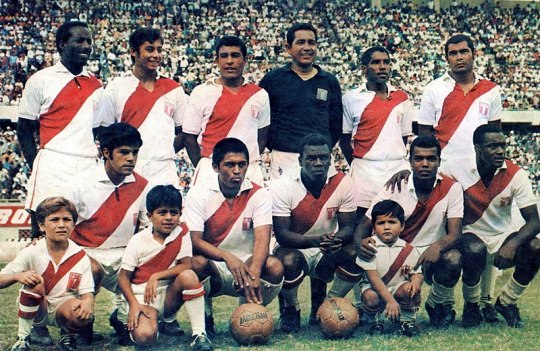
Peru 1970 National Football Team. Public domain, via Wikimedia Commons.
You may have noticed that the era we most associate with top striped socks is the 1960's and especially the 1970's. Another big trend that emerged at around the same time, and which coexisted beautifully with the aforementioned socks, was skating. Roller skating had already been around since 1760, and in a way it was roller skates that gave birth to the first skateboards in the late 1940's, which consisted of wooden planks with added roller skate wheels. The early 70's saw the invention of polyurethane wheels, which made for a smoother ride, better traction, and generally a more enjoyable experience. This precipitated a sudden rise in popularity for skating, and brought us the iconically 1970's skater fashions that we know and love today!

From the first Tokyo Bombers: Yasuko Sasaki, Tiger forest, Yumiko Horii, Rikki Endo, Kazuo Kono, Keiko Ayabe, Mickey Kakuda. Public domain via Wikimedia Commons.
For whatever reason, we found it next to impossible to find public domain photos of 1970's skateboarders, so while we aren't able to post the great photos we looked at here, we're happy to link you to them! We were really into this collection of Los Angeles skateboarders by photographer Hugh Holland. You can also find some interesting background information on how the skateboarding trend was influenced by a severe drought!
House Brand Top-Stripes
At last we have arrived at the point in our Sock Journal where we show you what we've got! Options for recreating this ultra-sporty look are luckily quite plentiful, so let's start out with some of our house brand options! While we only have two top-striped styles in our Dreamer Socks line, they're some heavy hitters! With 12 different colorways and 28 inch top-stretch, our Dreamer Americana Thigh Highs have rocketed into our top sellers! At a more classic length, the Retro Sport Socks come in three sporty colorways -- depending on your favorite team, we might even have your colors!

Dreamer Americana Thigh Highs * Retro Sport Socks
Our DreaM Stockings line includes a pretty great variety of top-striped styles, some of which are particularly good for that thicker, vintage vibe. Some are even authentically tube socks!
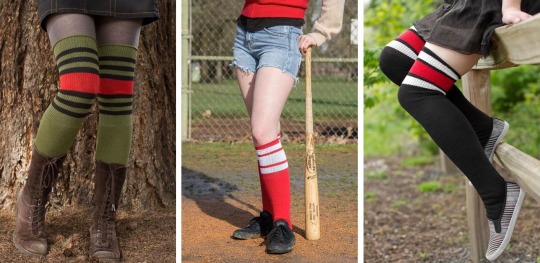
Dreamy Striped Over the Knee Tube Socks * Dreamy Knee High Tube Socks * Top Striped Over the Knee Tube Socks
The Skater Stripes (which are discontinued, so get yours while the getting's good!) and Sorcerer Socks are very similar beasts, only the skater stripes are a cotton blend and come in more stripe variations, while the Sorcerer Socks are nylon and feature colors for the Hogwarts houses.
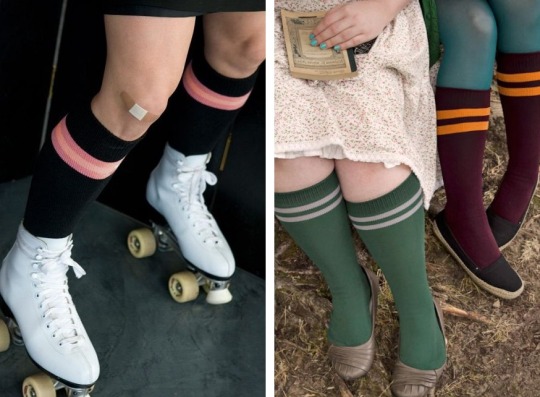
Skater Stripes * Sorcerer Socks
The Skater Stripes are being phased out in favor of some of the newer options we now carry, including the taller, ribbed Sporty Stripe Over the Knee Socks, which I previously mentioned are a pretty good match for those 1920's soccer uniform socks.

Sporty Stripe Over the Knee Socks
The final styles on our tour of house brand top stripes combine two of our favorite things: marled yarn and top-stripes! If you've been following our company over the years, you may have noticed our obsession with marled socks. There was an era when we couldn't find any marled yarns and had no marled socks (after years of carrying O Marleds - the precursor to our M45s and Confetti M45s, which are made on the same machines the O Marleds used to be knitted on) but we found ways of getting around that issue, which is what happens when you're utterly determined to have your favorite pattern. We think the marriage of these two patterns is a match made in heaven!

Top-Striped Marled Slouch Socks * Top-Striped Marled Scrunchable Socks
Other Suppliers's Top-Stripes
Of course we also carry lots of top striped styles from our other suppliers! For instance, most Gumball Poodle socks, which are made in the classic "cheer sock" style, come with top stripes, but some go above and beyond, incorporating the top stripe into the design, or in the case of their PRINCESS socks, turning it into a crown.
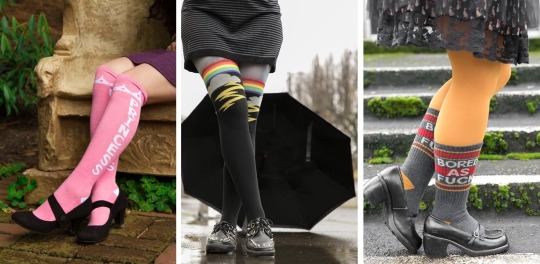
PRINCESS Knee Highs * Stormy Weather Over the Knee Socks * Bored AF Crews
Stance is another supplier that features a lot of top-stripes, and it's not too surprising given that their styles are geared towards skateboarders and surfers! We enjoy the way they mix it up with wild patterns from time to time, too!
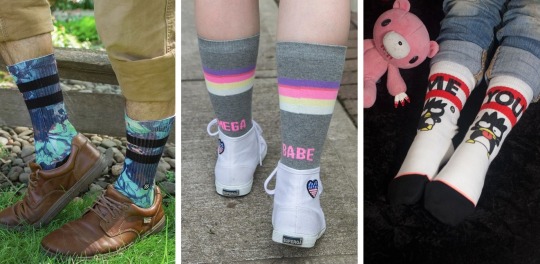
Durango Midcalves * Mega Babe Crews * Me Vs. You Kids' Crews
Another supplier that tends to surprise us with their top-stripes is Leg Avenue. Their offerings tend more towards the hosiery and lingerie end of the spectrum, and yet they manage to work some elegant top stripes into that wheelhouse, which is appropriately "full circle" given that we started out with those fancy 17th century stockings!
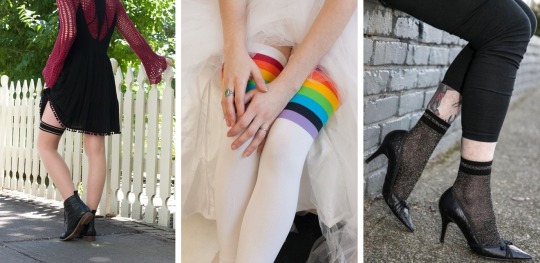
Sheer Stockings with Striped Tops * Over the Rainbow Thigh High * Lurex Anklets
Of course we have plenty of other top-striped options, but to feature all of them would make for a very long blog indeed. Instead, we encourage you to check out the entire top-striped collection, because there's a reason this look never seems to go out of fashion. As a style that has been around for centuries, top-stripes are truly timeless.
♥~Rosalind Socks by Sock Dreams • Free Shipping in the US • $5 International Shipping Find us on facebook | twitter | pinterest | instagram | sock journal | g+
#fashion#history#socks#sports#stripes#sport socks#top-stripes#hockey#football#soccer#american football#roller skating#skate boarding#sfw
54 notes
·
View notes
Link
What Can and Can’t Be Learned From a Doctor in China Who Pioneered Masks In late 1910, a deadly plague started spreading in the northeast reaches of China, reaching the large city of Harbin. Tens of thousands of people coughed up blood; their skin pruned and turned purple. They all died. This outbreak sent the Qing government into a tailspin: They didn’t know what illness was causing these deaths, let alone how to control it. So they brought in one of the best trained doctors in Asia at the time, Dr. Wu Lien-Teh. After performing autopsies, Dr. Wu found Yersini pestis, a bacterium similar to the one that had caused bubonic plague in the West. He recognized Manchuria’s plague as a respiratory disease and urged everyone, especially health care professionals and law enforcement, to wear masks. Chinese authorities, heeding his call, coupled masking with stringent lockdowns enforced by the police. Four months after the doctor was summoned, the plague ended. Although often overlooked in Western countries, Dr. Wu is recognized in world history as a pioneer of public health, helping to change the course of a respiratory disease spread by droplets that could have devastated China in the early 20th century, and perhaps spread far beyond its borders. While the Chinese of that era complied with these strategies, public health professionals in the United States and other Western countries have struggled to get people to listen to them during the Covid-19 pandemic. China, too, ran into challenges early on, but the country’s institutional memory from previous viral outbreaks helped turn the tide. And as many Americans abandon masking, push to restore normality in places where risks of infection remain high and hesitate to get vaccinated, some public health experts have looked to Dr. Wu’s success, seeking lessons on handling not only Covid, but also future epidemics. But some scholars who have studied Dr. Wu believe the wrong lesson is being drawn from his legacy: A single individual can’t save a nation. “We can’t always wait for historic figures,” said Alexandre White, a medical sociologist and historian at Johns Hopkins University in Baltimore. Instead, he and other experts say countries like the United States need to reckon with their inequitable and fraught public health systems so they can better contend with health threats. Dr. Wu was born to Chinese immigrants on March 10, 1879, on Penang, an island off the coast of Peninsular Malaysia, as Ngoh Lean Tuck. (He later changed his name to Wu Lien-Teh, sometimes spelled Wu Liande) When he was 17, Dr. Wu won a scholarship to study at Emmanuel College in England and stayed to study medicine at St Mary’s Hospital in London. As part of his training, he studied infectious diseases at the Liverpool School of Tropical Medicine and the Pasteur Institute in Paris. By 1903, when he returned to Malaysia, Dr. Wu was one of the earliest people of Chinese descent to graduate as a medical doctor from the West. In May 1908, Dr. Wu and his wife went to China, where he was appointed vice director of the Imperial Army College near Beijing, making him well-placed to investigate when people began dying from an unknown disease in Manchuria. Dr. Wu was entering a place where experts like him were in short supply and urgently needed. At the time, China was in political turmoil: Russia and Japan were vying for control over Manchuria and both saw the plague as an opportunity to advance their goals. Western countries at the time largely viewed China as “the sick man of the East,” a country overburdened by disease, opium addiction and an ineffective government. Historians who study China say the government accepted and internalized that label. But when Dr. Wu stepped in, he had the social and political clout to be a catalyst for change. Dr. Wu is often heralded as the “man behind the mask,” an inventor of using face coverings to prevent the spread of respiratory illnesses. Much of this narrative was by his own design in his autobiography, said Marta Hanson, a historian of medicine also at Johns Hopkins. Previous iterations of the mask existed in other countries, and some Chinese were already donning Japanese-style respirators before Dr. Wu arrived in Harbin. What is true is that Dr. Wu introduced and encouraged an idea born in the West to the Chinese public. The mask he designed was based on ventilators from the Victorian era: padding layers of cotton and gauze, with strings so that the user could secure it to their head. The mask was cheap and easy to manufacture. In addition to masks, officials enforced a strict cordon sanitaire, another method that dates back at least to the 1800s when French officials sought to contain the spread of Yellow Fever. Travel was restricted, government officers were instructed to shoot anyone trying to escape, and police officers went door to door, looking for anyone who had died from plague. In an echo of some of these techniques last year during the fight against Covid, China strictly curtailed transportation around Wuhan, and people needed permission from authorities to leave their homes. The spring after the plague was brought under control in China, Dr. Wu hosted the International Plague Conference. Respirators and masks were a focal point of conversation, and many Western scholars believed that they could effectively prevent plague. While masks became a political flash point in the United States and elsewhere during the Spanish flu pandemic, the idea of using them persisted in China, and gauze masks became an important tool in the political agenda of the Nationalist Party when it took over in 1928. Public health officials recommended all citizens wear gauze masks in public spaces during outbreaks of meningitis or cholera. By then, masks became a symbol of hygienic modernity, contributing to the greater acceptance of mask-wearing in China today, Dr. Hanson said. In the early 21st century, the SARS epidemic once again drove home the necessity of masks and other public health interventions in China and other East Asian countries. In 1930, Dr. Wu was appointed to head a new national health organization. But after the Japanese invaded northern China in 1937, and his home in Shanghai was shelled, Dr. Wu sought refuge in his native Malaysia. He finished his career there as a family doctor, and died in 1960, at 80 years old. Medical historians and public health experts have a few theories to explain Dr. Wu’s success in persuading Chinese authorities to control the plague. A factor that likely helped Dr. Wu, medical historians say, is that he made masks affordable and accessible. A similar approach was used during the coronavirus pandemic in Hong Kong, which offered every resident a free, reusable mask and put kiosks in public to distribute them. Countries that have provided significant support to their citizens to comply with public health mandates during this pandemic have generally fared better than places that left the same measures up to individuals, Dr. White of Johns Hopkins said. And the more affordable and accessible public health measures are to adopt, the more likely they are to be adopted, said Kyle Legleiter, the senior director of policy advocacy at The Colorado Health Foundation. Another factor that might have contributed to Dr. Wu’s success in China would be the reverence residents and officials had for him as a figure of authority, Yanzhong Huang, a senior fellow for global health at the Council on Foreign Relations, said. In some ways, Dr. Anthony Fauci, the chief medical adviser on Covid to President Biden and a prominent public health figure since the 1980s, served in a role similar to the one Wu played in China, Dr. Huang said. But, his message perhaps didn’t always get through because Americans are more polarized in their political identities and beliefs. Dr. Legleiter added that public health messaging only penetrates if the public identifies with or trusts that figure of authority. “An individual person is a stand-in for a broader set of institutions or systems that they’re speaking on the behalf of,” Dr. Legleiter said. Those who lean conservative, for instance, may put Dr. Fauci and other scientists in the category of “the elites.” As such, they’re more likely to flout public health policies that such authority figures promote, and comply with proclamations from individuals they identify with the most. Others say that public health is intrinsically tied to the legitimacy of the state promoting it. At the turn of the 20th century, China was in distress, Dr. Hanson said. Dr. Wu helped bring China out of a tumultuous period, and the enforcement of public health measures gave the country more legitimacy. Similarly, because the current pandemic has laid bare shortcomings in the public health systems in the United States, Britain and other Western countries, some experts believe it can be a catalyst for change. “Since the mid-19th century, the West has generally seen its ability to control infectious disease as a marker of their civilizational superiority over much of the rest of the world,” Dr. White said. While China was seen as the sick man of the world then, some commentators in China now attempt to brand the United States with that label. Ruth Rogaski, a medical historian at Vanderbilt University who specializes in studying the Qing dynasty and modern China, believes that the coronavirus crisis similarly offers an opportunity for reflection, which can be very motivating. “Epidemics can serve as inflection points,” Dr. Rogaski said. “Opportunities to rethink, retool and even revolutionize approaches to health.” Source link Orbem News #China #Doctor #Learned #Masks #Pioneered
1 note
·
View note
Text
A Century of Glamour Ghouls: 1960s
Marianne Danielle in The Brides of Dracula (1960)

The Movie
Sometime in the late 19th century, somewhere east of France, those damned dapper, aristocratic vampires are at it again. Two years after Horror of Dracula (1958) was a smash hit for Hammer Film Productions, The Brides of Dracula (1960) was produced. Dracula didn’t rise from the grave for this one, but Van Helsing continues on his quest to wipe out his blood-sucking kin.
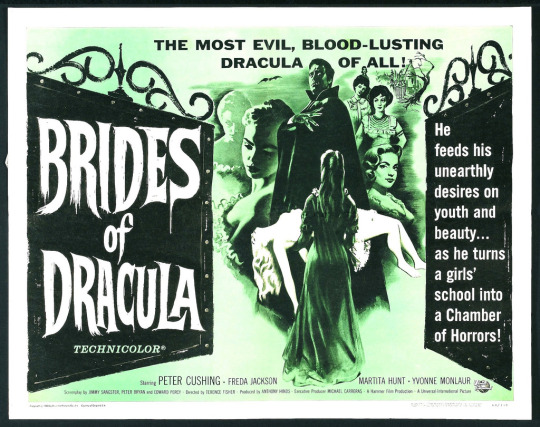
The film begins when Marianne Danielle (Yvonne Monlaur), a deportment teacher from Paris, encounters coach trouble en route to a new job. Stranded at the village inn, Marianne meets the Baroness Meinster who invites her to stay the night at her chateau. Marianne soon discovers that the Baroness has been keeping a secret; the Baroness’ “ill” son is locked up in his own wing of the chateau. Misunderstanding the nature of the Baron’s affliction Marianne executes a plan to set him free. The Baron then murders his own mother before escaping into the night. Marianne, distraught at being left behind, flees through the woods where she is found in passed out in shock and exhaustion by Dr. Van Helsing, who is investigating rumors around the Meinster family. A rash of strange murders break out in the village and Van Helsing closes in on the Baron. Unbeknownst to Van Helsing, Marianne has agreed to marry the Baron, still not aware that he is a vampire.

When Hammer began producing their own set of adaptations of the classic movie monsters, they established a colorful gothic universe that stretched well beyond the initial characters, scenarios, and stories. Brides sets the tone for all of the Hammer vampire films that followed. They’re stylish period pieces, though which period can be a little muddy giving the films an added fantastical quality. They have a pronounced gothic flair.
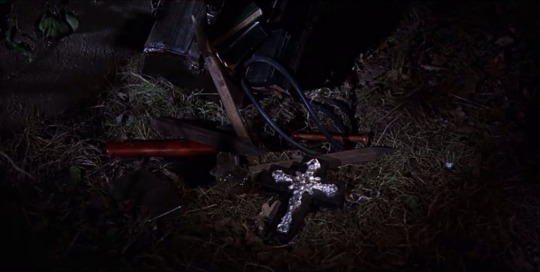
While no Hammer film is absent of camp, their first decade of horror was a bit more reserved in style and content. Hammer bucked censors from the start with The Quatermass Xperiment (1955) when they not only didn’t fret an X rating, but changed the title of the film to publicize that X. It wouldn’t be until the end of the 1960s that Hammer would push for the pulpy provocative content, nudity, and lesbianism closely associated with the later Hammer vampire films, but the seeds for that progression (or regression depending on how you look at it) are already visible in Brides.

The Look
A hallmark of Hammer horror is glossy glam taking precedent over historical accuracy in costuming and makeup design. Marianne is no exception.

The Clothes
The film is roughly set at the end of the 19th century and Marianne’s costuming doesn’t reflect that exactly but it’s quite consistent throughout the film.
Marianne is always in long dresses, with long tapered sleeves and puffy shoulders. Most of her collars make a high v. Marianne is often costumed in deep colors (warm grey with red detailing, forest green, crimson, etc.) and velvety fabrics.

This contrasts her from the Meinsters, who are typically costumed in cool grayish and purple shades and often in fussier fabrics like silk and embellished lace.

(In addition, when people encounter the Baron for the first time either to get vamped or put in his thrall, they’re usually wearing a cool purple shade.)

She also has the best winter coat I’ve ever seen in my life and if anyone knows where I can get this exact coat HMU.

For the daytime look, I wanted to translate the Marianne costuming philosophy into something more contemporary. I didn’t succeed very well with colors, but hey. I chose a knit button-up top with lace detailing and a little puff at the sleeves and a velvet mini skirt. To add some deep colors to the look, I wore purple tights (though the camera didn’t pick up the hue well).
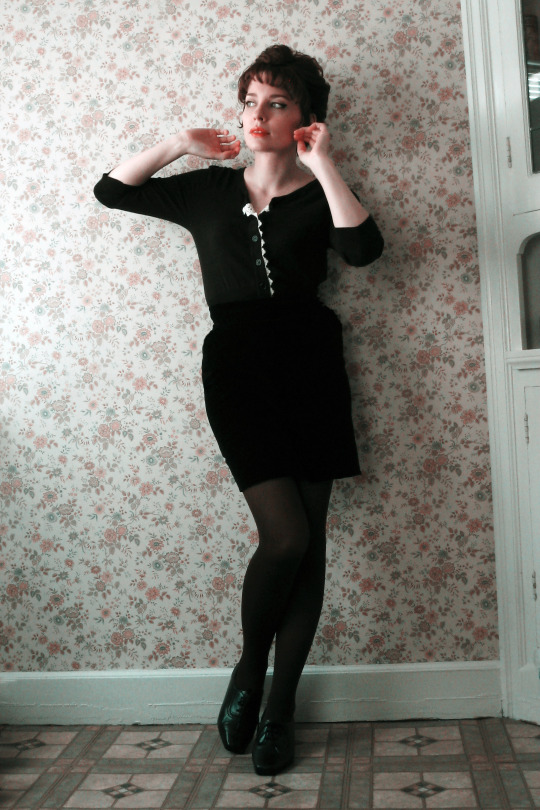
For the full cosplay, I stuck with a velvet skirt (ideally it’d be ankle-length, but I don’t have many ankle-length skirts). This time I paired it with a cream-colored high-necked blouse under a black fitted blazer that I tucked into the skirt, trying to mimic the style of dress Marianne wears in the film. On top of that, I added a plaid capelet with brown and white detailing and white scarf.
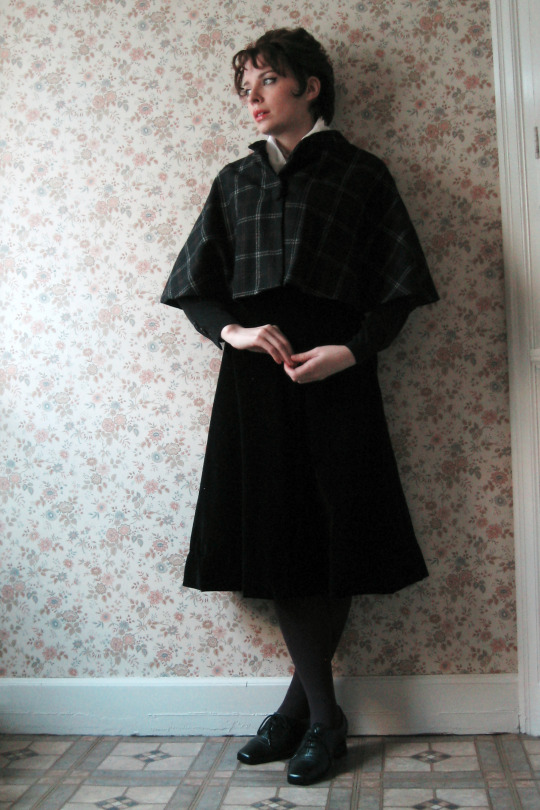
Recreating Marianne’s look simply from my own closet was easier said than done. If you’d like to be a generic woman from Hammer horror, era-appropriate dresses are usually easy to find in vintage stores and could be paired with the makeup below. Case in point, me on Halloween 3 years ago:
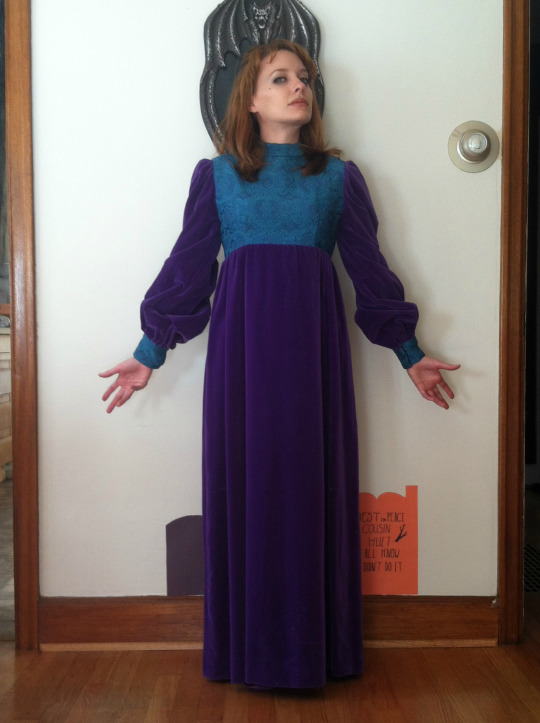
The Makeup
Marianne’s makeup is definitely a look that could pass for modern, so I’ll only do a single face for both levels of cosplay. It’s a high-contrast look but with warm, romantic colors. A great look for autumn to be honest.

Start with an even base with a natural or semi-matte finish. Cover your lids with a neutral shade either in your skin tone or one shade lighter.
Take a neutral or warm purple shade into the crease and outer edge of your lid and blend up. Follow that up with a lighter shade on the lid and just below the brow to create contrast; I chose a pale yellow.

The liner is pretty intense so if you need extra guidance on wings, I talked covered my method in the 1950s. (1.) Start with a thin line of eyeliner right at the lashline. (2.) With your eyes open, looking straight into the mirror, draw out an upward swinging triangle on the outside of your eye and fill it in. (3.) Take a thin angled brush with black or dark brown shadow, smooth the liner and connect the wing with your lower lashline with what is left on the brush. (4.) Finish the eyes up with a few coats of black mascara and, if you like, go into the upper waterline with black liner.

Contouring wasn’t big in 1960, but sculpting with blush certainly was. Take a warm blush and go over the tops of your cheekbones and below them all the way to your ear.
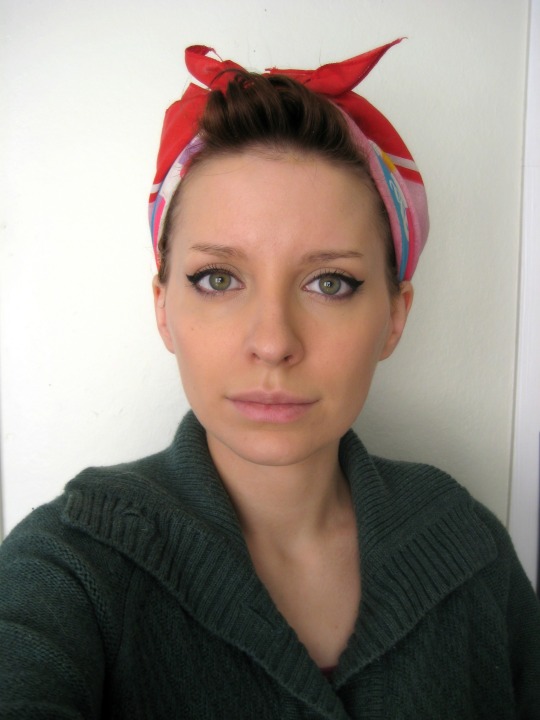
Marianne’s eyebrows are strong but relatively straight. I took a warm brown pencil to draw out the whole shape then softened it with light brown powder and a clean spoolie.
Go back into your eyeliner and, with a small pointed brush place a beauty mark on top of your left cheekbone but below your eye.

Marianne’s lips are full and overlined a little to soften the lipline. Go in with a coral pink liner and round out the shape of your upper lip, particularly making sure the cupid’s bow is obscured. On the bottom lip, draw inward a little at the edges to focus the fullness on the middle of your lip. Then fill in your lips with a glossy coral pink lipstick or lipgloss if you feel that it’s too much with the eyes and cheeks.

If you wanted to glam it up further, long wispy false lashes would be perfect.

If you have the hair to properly recreate Marianne’s style, this Loepsie tutorial will serve you well.
The 1910s | The 1920s | The 1930s | The 1940s | The 1950s | The 1970s | The 1980s | The 1990s | The 2000s
#A Century of Glamour Ghouls#horror#horror movies#horror film#hammer films#hammer horror#the brides of dracula#brides of dracula#yvonne monlaur#British film#movie#film#classic film#glamour#glam#vintage#vintage inspired#true vintage#1960s#1960s fashion#1960s movies#makeup#makeup tutorial#fashion#halloween#halloween costumes#closet cosplay#instructional#costume#cosplay
270 notes
·
View notes